Varanasi
Varanasi (Hindustani pronunciation: [ʋaːˈraːɳəsi] (![]()
![]()
![]()
Varanasi | |
|---|---|
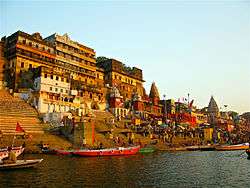 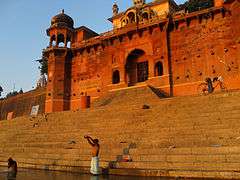    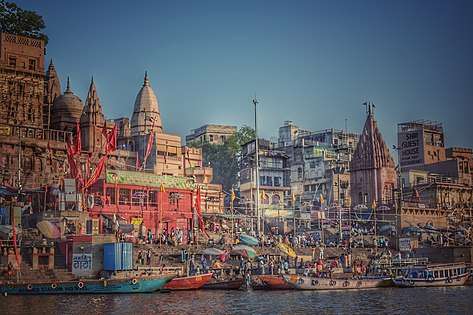 Left to Right, Top to Bottom:
Ahilya Ghat, Chet Singh Ghat, Kedar Ghat, Ganga Aarti at Dashashwamedh Ghat, Ganges River bank along Varanasi, Man offering prayers to the river Ganga, Dashashwamedh Ghat | |
| Nickname(s): The spiritual capital of India | |
 Varanasi Location in Uttar Pradesh  Varanasi Varanasi (India) 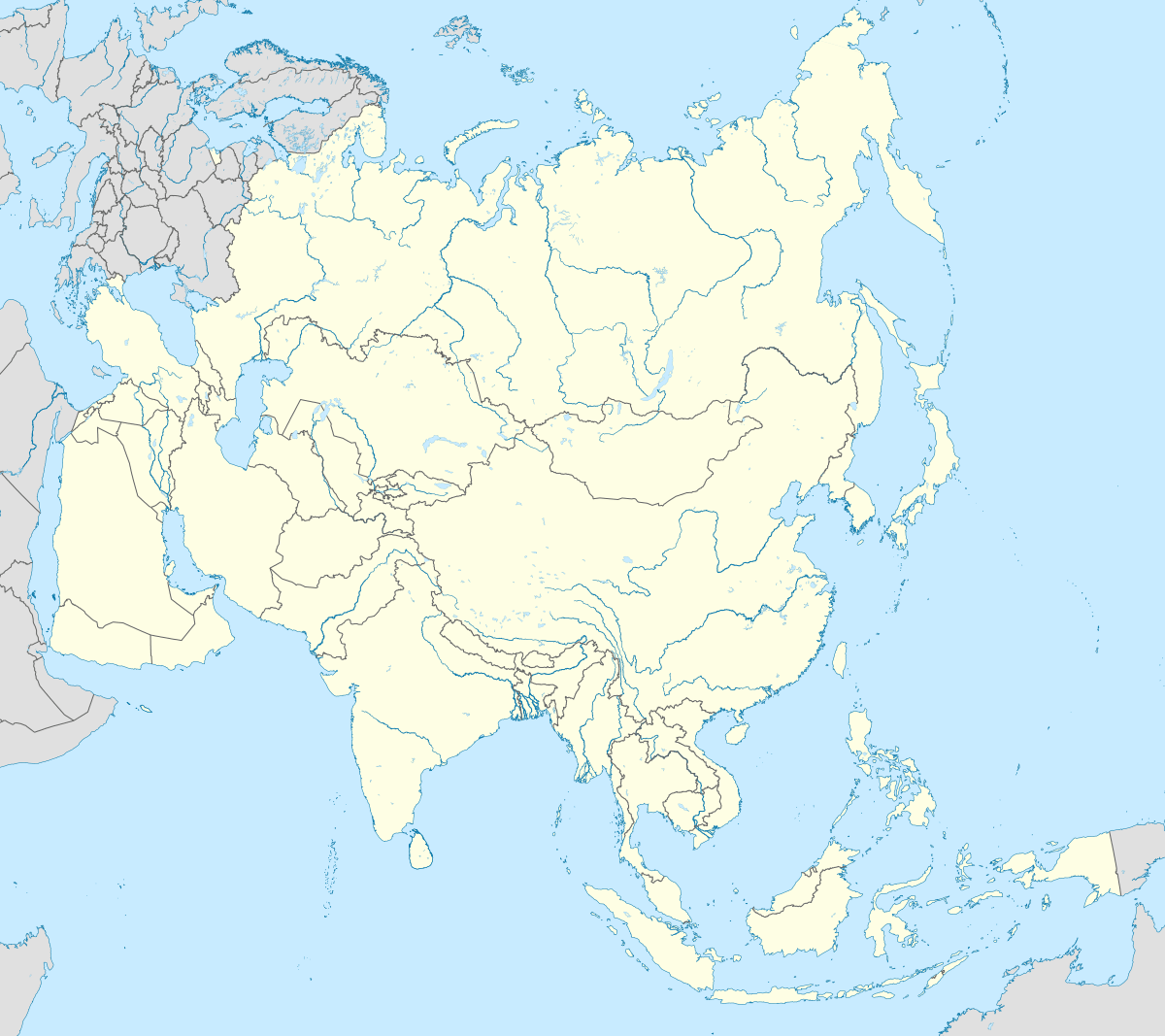 Varanasi Varanasi (Asia) | |
| Coordinates: 25°19′08″N 83°00′46″E | |
| Country | |
| State | Uttar Pradesh |
| Division | Varanasi |
| District | Varanasi |
| Government | |
| • Type | Municipal Corporation |
| • Body | Varanasi Municipal Corporation |
| • Mayor | Mridula Jaiswal (BJP) |
| • Divisional Commissioner | Deepak Agarwal, IAS |
| • District Magistrate | Kaushal Raj Sharma, IAS |
| • Inspector General, Varanasi Range | Vijay Singh Meena, IPS |
| • Senior Superintendent of Police | Prabhakar Chaudhary, IPS |
| Area | |
| • Metropolis | 163.8 km2 (63.2 sq mi) |
| Elevation | 80.71 m (264.80 ft) |
| Population (2011) | |
| • Metropolis | 1,201,815 |
| • Rank | 31th |
| • Density | 7,300/km2 (19,000/sq mi) |
| • Metro | 1,432,280 (32nd) |
| Language | |
| • Official | Hindi[4] |
| • Additional official | Urdu[4] |
| • Regional | Bhojpuri |
| Time zone | UTC+5:30 (IST) |
| PIN | 221 001 to** (** area code) |
| Telephone code | 0542 |
| Vehicle registration | UP 65 |
| GDP | $3.07 billion (2016–17)[5] |
| Per capita income | INR 1,93 616[6] |
| Sex ratio | 0.926 (2011) ♂/♀ |
| Literacy (2011) | 80.31%[7] |
| HDI | 0.645[8] |
| Website | varanasi |
| Part of a series on |
| Vaishnavism |
|---|
 |
|
Holy scriptures
|
|
Sampradayas
|
|
Related traditions |
|
|
| Part of a series on |
| Shaivism |
|---|
 |
|
Scriptures and texts
|
|
Philosophy
|
|
Practices |
|
Schools
Saiddhantika Non - Saiddhantika
|
|
Related
|
Varanasi grew as an important industrial centre famous for its muslin and silk fabrics, perfumes, ivory works, and sculpture. Buddha is believed to have founded Buddhism here around 528 BCE when he gave his first sermon, "The Setting in Motion of the Wheel of Dharma", at nearby Sarnath. The city's religious importance continued to grow in the 8th century, when Adi Shankara established the worship of Shiva as an official sect of Varanasi. During the Muslim rule through the Middle Ages, the city continued as an important centre of Hindu devotion, pilgrimage, mysticism and poetry which further contributed to its reputation as a centre of cultural importance and religious education. Tulsidas wrote his epic poem on Rama's life called Ram Charit Manas in Varanasi. Several other major figures of the Bhakti movement were born in Varanasi, including Kabir and Ravidas.[10] Guru Nanak visited Varanasi for Maha Shivaratri in 1507, a trip that played a large role in the founding of Sikhism.
In the 16th century, Varanasi had a cultural revival under the Mughal emperor Akbar who patronised the city, and built two large temples dedicated to Shiva and Vishnu. Much of what is considered modern Varanasi was built during the 18th century, by the Maratha and Bhumihar Brahmin kings. The Kingdom of Benares was given official status by the Mughals in 1737, and continued as a dynasty-governed area until Indian independence in 1947. The city is governed by the Varanasi Nagar Nigam (Municipal Corporation) and is represented in the Parliament of India by the current Prime Minister of India Narendra Modi, who won the Lok Sabha elections in 2014 by a huge margin. Silk weaving, carpets and crafts and tourism employ a significant number of the local population, as do the Diesel Locomotive Works and Bharat Heavy Electricals. Varanasi Hospital's foundation stone was laid by governor Kanaiyalal Maneklal Munshi in 1954 and it was inaugurated by president S. Radhakrishnan in 1964.[11]
Varanasi has been a cultural centre of northern India for several thousand years, and is closely associated with the Ganges. Hindus believe that dying here and getting cremated along the banks of the "holy" Ganges river allows one to break the cycle of rebirth and attain salvation,[12] making it a major center for pilgrimage. The city is known worldwide for its many ghats, embankments made in steps of stone slabs along the river bank where pilgrims perform ritual ablutions. Of particular note are the Dashashwamedh Ghat, the Panchganga Ghat, the Manikarnika Ghat, and the Harishchandra Ghat, the last two being where Hindus cremate their dead. The Hindu genealogy registers at Varanasi are kept here.
The Ramnagar Fort, near the eastern bank of the Ganges, was built in the 18th century in the Mughal style of architecture, featuring carved balconies, open courtyards, and scenic pavilions. Among the estimated 23,000 temples in Varanasi are Kashi Vishwanath Temple of Shiva, the Sankat Mochan Hanuman Temple, and the Durga Temple. The Kashi Naresh (Maharaja of Kashi) is the chief cultural patron of Varanasi, and an essential part of all religious celebrations. The city has long been an educational and musical centre: many prominent Indian philosophers, poets, writers, and musicians live or have lived in the city, and it was the place where the Benares gharana form of Hindustani classical music was developed. One of Asia's largest residential universities is Banaras Hindu University (BHU).
Etymology
Traditional etymology links "Varanasi" to the names of two Ganges tributaries forming the city's borders: Varuna, still flowing in northern Varanasi, and Assi, today a small stream in the southern part of the city, near Assi Ghat. The old city is located on the north shores of the Ganges, bounded by Varuna and Assi.[13]
In the Rigveda, an ancient Indian sacred collection of Vedic Sanskrit hymns, the city is referred to as Kāśī (काशी: Kashi) from the Sanskrit verbal root kaś- "to shine", making Varanasi known as "City of Light",[14] the "luminous city as an eminent seat of learning".[15] The name was also used by pilgrims dating from Buddha's days.
Hindu religious texts use many epithets to refer to Varanasi, such as Kāśikā (काशिका: Sanskrit: "the shining one"), Avimukta (अविमुक्त: Sanskrit: "never forsaken" by Shiva), Ānandavana (आनंदवना: Sanskrit: "the forest of bliss"), and Rudravāsa (रुद्रवासा: Sanskrit: "the place where Rudra/Śiva resides").[1]
History
Hindu mythology
According to Hindu mythology, Varanasi was founded by Shiva,[16] one of three principal deities along with Brahma and Vishnu. During a fight between Brahma and Shiva, one of Brahma's five heads was torn off by Shiva. As was the custom, the victor carried the slain adversary's head in his hand and let it hang down from his hand as an act of ignominy, and a sign of his own bravery. A bridle was also put into the mouth. Shiva thus dishonored Brahma's head, and kept it with him at all times. When he came to the city of Varanasi in this state, the hanging head of Brahma dropped from Shiva's hand and disappeared in the ground. Varanasi is therefore considered an extremely holy site.[17]
The Pandavas, the protagonists of the Hindu epic Mahabharata, are said to have visited the city in search of Shiva to atone for their sin of fratricide and Brāhmanahatya that they had committed during the climactic Kurukshetra War.[18] It is regarded as one of seven holy cities (Sapta Puri) which can provide Moksha; Ayodhya, Mathura, Haridwar, Kashi, Kanchi, Avanti, and Dvārakā are the seven cities known as the givers of liberation.[19] The princesses Ambika and Ambalika of Kashi were wed to the Hastinapur ruler Vichitravirya, and they later gave birth to Pandu and Dhritarashtra. Bhima, a son of Pandu, married a Kashi princess Valandhara and their union resulted in the birth of Sarvaga, who later ruled Kashi. Dhritarasthra's eldest son Duryodhana also married a Kashi princess Bhanumati, who later bore him a son Lakshman Kumara and a daughter Lakshmanaa.
Archaeological evidence
Excavations in 2014 led to the discovery of artefacts dating back to 800 BCE. Further excavations at Aktha and Ramnagar, two sites in the vicinity of the city, unearthed artefacts dating back to 1800 BCE, supporting the view that the area was inhabited by this time.[20]
Ancient period
Varanasi grew as an important industrial centre, famous for its muslin and silk fabrics, perfumes, ivory works, and sculpture.[21] During the time of Gautama Buddha, Varanasi was part of the Kingdom of Kashi.[21] The Buddha is believed to have founded Buddhism here around 528 BCE when he gave his first sermon, "The Setting in Motion of the Wheel of Dharma", at nearby Sarnath.[22][23] The celebrated Chinese traveller Xuanzang, also known as Hiuen Tsiang, who visited the city around 635 CE, attested that the city was a centre of religious and artistic activities, and that it extended for about 5 kilometres (3.1 mi) along the western bank of the Ganges.[21][24] When Xuanzang, visited Varanasi in the 7th century, he named it "Polonise" (婆羅痆斯) and wrote that the city had some 30 temples with about 30 monks.[25] The city's religious importance continued to grow in the 8th century, when Adi Shankara established the worship of Shiva as an official sect of Varanasi.[26]
Medieval period
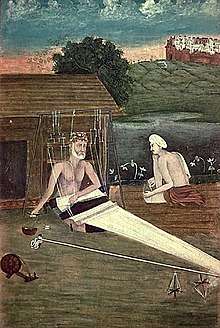
Chandradeva, founder of the Gahadavala dynasty made Banaras a second capital in 1090.[27] After fall of Pala Empire, the Chero dynasty ruled Varanasi till Mughal rule.[28][29]
Varanasi remained a centre of activity for intellectuals and theologians during the Middle Ages, which further contributed to its reputation as a cultural centre of religion and education. Several major figures of the Bhakti movement were born in Varanasi, including Kabir who was born here in 1389,[30] and Ravidas, a 15th-century socio-religious reformer, mystic, poet, traveller, and spiritual figure, who was born and lived in the city and employed in the tannery industry.[31]
Early Modern to Modern periods (1500–1949)
 A lithograph by James Prinsep (1832) of a Brahmin placing a garland on the holiest location in the city.
A lithograph by James Prinsep (1832) of a Brahmin placing a garland on the holiest location in the city.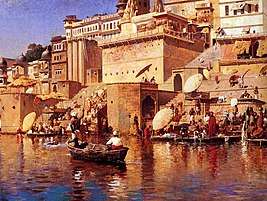 A painting by Edwin Lord Weeks (1883) of Varanasi, viewed from the Ganges.
A painting by Edwin Lord Weeks (1883) of Varanasi, viewed from the Ganges.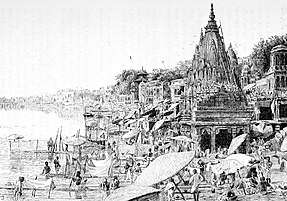 An illustration (1890) of Bathing Ghat in Varanasi.
An illustration (1890) of Bathing Ghat in Varanasi.
Numerous eminent scholars and preachers visited the city from across India and South Asia. Guru Nanak visited Varanasi for Maha Shivaratri in 1507, a trip that played a large role in the founding of Sikhism.[32]
Varanasi experienced a Hindu cultural revival in the 16th century under the Mughal emperor Akbar, who invested in the city and funded to build two large temples dedicated to Shiva and Vishnu.[24] The Raja of Pune established the Annapurna Mandir, and the 200-metre (660 ft) Akbari Bridge was also completed during this period.[33] The earliest tourists began arriving in the city during the 16th century.[34] In 1665, the French traveller Jean-Baptiste Tavernier described the architectural beauty of the Vindu Madhava temple on the side of the Ganges. The road infrastructure was also improved during this period. It was extended from Kolkata to Peshawar by Emperor Sher Shah Suri; later during the British Raj it came to be known as the famous Grand Trunk Road. In 1656, Emperor Aurangzeb ordered the destruction of many temples and the building of mosques, causing the city to experience a temporary setback.[24] However, after Aurangazeb's death, most of India was ruled by a confederacy of pro-Hindu kings. Much of modern Varanasi was built during this time, especially during the 18th century by the Maratha and Bhumihar Brahmin Kings.[35] The kings governing Varanasi continued to wield power and importance through much of the British Raj period, including the Maharaja of Benares, or simply called by the people of Benaras as Kashi Naresh.
The Kingdom of Benares was given official status by the Mughals in 1737, and continued as a dynasty-governed area until Indian independence in 1947, during the reign of Dr. Vibhuti Narayan Singh. In the 18th century, Muhammad Shah ordered the construction of an observatory on the Ganges, attached to Man Mandir Ghat, designed to discover imperfections in the calendar in order to revise existing astronomical tables. Tourism in the city began to flourish in the 18th century.[34] In 1791, under the rule of the British Governor-General Warren Hastings, Jonathan Duncan founded a Sanskrit College in Varanasi.[36] In 1867, the establishment of the Varanasi Municipal Board led to significant improvements in the city's infrastructure and basic amenities of health services, drinking water supply and sanitation [37]
Author Mark Twain wrote in 1897 of Varanasi, "Benares is older than history, older than tradition, older even than legend, and looks twice as old as all of them put together."[38] In 1910, the British made Varanasi a new Indian state, with Ramnagar as its capital, but with no jurisdiction over the city proper. The religious head, Kashi Naresh, has had his headquarters at the Ramnagar Fort since the 18th century, also a repository of the history of the kings of Varanasi, which is situated to the east of Varanasi, across the Ganges.[39] The Kashi Naresh is deeply revered by the local people and the chief cultural patron; some devout inhabitants consider him to be the incarnation of Shiva.[40]
Annie Besant founded the Central Hindu College, which later became a foundation for the creation of Banaras Hindu University in 1916. Besant founded the college because she wanted "to bring men of all religions together under the ideal of brotherhood in order to promote Indian cultural values and to remove ill-will among different sections of the Indian population."[41]
Varanasi was ceded to the Union of India in 1947, becoming part of Uttar Pradesh after Indian independence.[42] Vibhuti Narayan Singh incorporated his territories into the United Provinces in 1949.
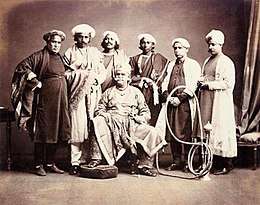 Maharaja of Benares, 1870s.
Maharaja of Benares, 1870s..jpg) Map of the city, c. 1914.
Map of the city, c. 1914.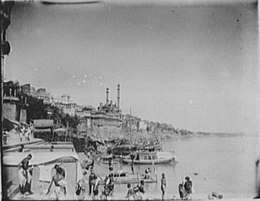 An 1895 photograph of the Varanasi riverfront.
An 1895 photograph of the Varanasi riverfront. The lanes of Varanasi are bathed in a plethora of colours.
The lanes of Varanasi are bathed in a plethora of colours.
Geography and climate
Geography
Varanasi is located at an elevation of 80.71 metres (264.8 ft)[43] in the centre of the Ganges valley of North India, in the Eastern part of the state of Uttar Pradesh, along the left crescent-shaped bank of the Ganges, averaging between 15 metres (50 ft) and 21 metres (70 ft) above the river.[44] The city is the headquarters of Varanasi district. By road, Varanasi is located 797 kilometres (495 mi) south-east of New Delhi, 320 kilometres (200 mi) south-east of Lucknow, 121 kilometres (75 mi) east of Allahabad, and 63 kilometres (39 mi) south of Jaunpur.[45] The "Varanasi Urban Agglomeration" – an agglomeration of seven urban sub-units – covers an area of 112.26 km2 (43.34 sq mi).[46] Neighbourhoods of the city include Adampura, Anandbagh, Bachchhaon, Bangali Tola, Bhelpura, Bulanala, Chaitganj, Chaukaghat, Chowk, Dhupchandi, Dumraon, Gandhinagar, Gautam Nagar, Giri Nagar, Gopal Vihar, Guru Nanak Nagar, Jaitpura, Kail Garh, Khanna, Kotwali, Lanka Manduadih, Luxa, Maheshpur, Mahmoorganj, Maulvibagh, Nagwar, Naipokhari, Shivala, Siddhagiribagh, and Sigra.[45]
Located in the Indo-Gangetic Plains of North India, the land is very fertile because low-level floods in the Ganges continually replenish the soil.[47] Varanasi is situated between the Ganges confluences with two rivers: the Varuna and the Assi stream. The distance between the two confluences is around 2 miles (4 km), and serves as a sacred journeying route for Hindus, which culminates with a visit to a Sakshi Vinayak Temple.[48]
Climate
Varanasi experiences a humid subtropical climate (Köppen climate classification Cwa) with large variations between summer and winter temperatures.[49][50] The dry summer starts in April and lasts until June, followed by the monsoon season from July to October. The temperature ranges between 22 and 46 °C (72 and 115 °F) in the summers. Winters in Varanasi see very large diurnal variations, with warm days and downright cold nights. Cold waves from the Himalayan region cause temperatures to dip across the city in the winter from December to February and temperatures below 5 °C (41 °F) are not uncommon. The average annual rainfall is 1,110 mm (44 in). Fog is common in the winters, while hot dry winds, called loo, blow in the summers.[51] In recent years, the water level of the Ganges has decreased significantly; upstream dams, unregulated water extraction, and dwindling glacial sources due to global warming may be to blame.[52][53]
| Climate data for Varanasi (1981–2010, extremes 1901–2012) | |||||||||||||
|---|---|---|---|---|---|---|---|---|---|---|---|---|---|
| Month | Jan | Feb | Mar | Apr | May | Jun | Jul | Aug | Sep | Oct | Nov | Dec | Year |
| Record high °C (°F) | 31.4 (88.5) |
36.1 (97.0) |
41.5 (106.7) |
45.2 (113.4) |
47.2 (117.0) |
47.2 (117.0) |
45.0 (113.0) |
40.1 (104.2) |
39.7 (103.5) |
39.4 (102.9) |
36.0 (96.8) |
32.8 (91.0) |
47.2 (117.0) |
| Average high °C (°F) | 22.5 (72.5) |
26.5 (79.7) |
32.7 (90.9) |
38.8 (101.8) |
40.1 (104.2) |
38.3 (100.9) |
33.8 (92.8) |
33.0 (91.4) |
32.9 (91.2) |
32.4 (90.3) |
29.3 (84.7) |
24.7 (76.5) |
32.1 (89.8) |
| Average low °C (°F) | 8.9 (48.0) |
11.7 (53.1) |
16.3 (61.3) |
21.6 (70.9) |
25.3 (77.5) |
27.1 (80.8) |
25.9 (78.6) |
25.6 (78.1) |
24.6 (76.3) |
20.3 (68.5) |
14.0 (57.2) |
9.8 (49.6) |
19.3 (66.7) |
| Record low °C (°F) | 1.0 (33.8) |
1.7 (35.1) |
6.7 (44.1) |
11.1 (52.0) |
17.3 (63.1) |
20.5 (68.9) |
20.0 (68.0) |
20.4 (68.7) |
17.8 (64.0) |
11.7 (53.1) |
5.0 (41.0) |
2.2 (36.0) |
1.0 (33.8) |
| Average rainfall mm (inches) | 16.7 (0.66) |
22.8 (0.90) |
9.2 (0.36) |
5.7 (0.22) |
16.8 (0.66) |
106.8 (4.20) |
260.9 (10.27) |
280.8 (11.06) |
228.9 (9.01) |
29.0 (1.14) |
7.2 (0.28) |
4.2 (0.17) |
989.0 (38.94) |
| Average rainy days | 1.5 | 1.8 | 0.7 | 0.7 | 1.7 | 5.2 | 12.9 | 12.5 | 9.1 | 1.9 | 0.4 | 0.4 | 48.7 |
| Average relative humidity (%) (at 17:30 IST) | 63 | 50 | 35 | 25 | 31 | 50 | 74 | 78 | 77 | 68 | 66 | 66 | 57 |
| Mean monthly sunshine hours | 232.5 | 240.1 | 291.4 | 294.0 | 300.7 | 234.0 | 142.6 | 189.1 | 195.0 | 257.3 | 261.0 | 210.8 | 2,848.5 |
| Mean daily sunshine hours | 7.5 | 8.5 | 9.4 | 9.8 | 9.7 | 7.8 | 4.6 | 6.1 | 6.5 | 8.3 | 8.7 | 6.8 | 7.8 |
| Source: India Meteorological Department (sun 1971–2000)[54][55][56] | |||||||||||||
| Climate data for Varanasi Airport (1981–2010, extremes 1952–2012) | |||||||||||||
|---|---|---|---|---|---|---|---|---|---|---|---|---|---|
| Month | Jan | Feb | Mar | Apr | May | Jun | Jul | Aug | Sep | Oct | Nov | Dec | Year |
| Record high °C (°F) | 32.3 (90.1) |
35.8 (96.4) |
42.4 (108.3) |
45.3 (113.5) |
46.8 (116.2) |
48.0 (118.4) |
43.9 (111.0) |
39.8 (103.6) |
42.3 (108.1) |
39.0 (102.2) |
35.3 (95.5) |
32.7 (90.9) |
48.0 (118.4) |
| Average high °C (°F) | 22.8 (73.0) |
26.8 (80.2) |
33.2 (91.8) |
39.2 (102.6) |
40.3 (104.5) |
38.7 (101.7) |
34.2 (93.6) |
33.3 (91.9) |
33.2 (91.8) |
33.0 (91.4) |
29.7 (85.5) |
24.9 (76.8) |
32.4 (90.3) |
| Average low °C (°F) | 9.1 (48.4) |
11.8 (53.2) |
16.3 (61.3) |
21.8 (71.2) |
25.3 (77.5) |
27.3 (81.1) |
26.4 (79.5) |
26.1 (79.0) |
25.1 (77.2) |
20.7 (69.3) |
14.6 (58.3) |
10.2 (50.4) |
19.6 (67.3) |
| Record low °C (°F) | 0.3 (32.5) |
2.4 (36.3) |
7.9 (46.2) |
11.4 (52.5) |
17.8 (64.0) |
14.3 (57.7) |
21.4 (70.5) |
21.7 (71.1) |
19.1 (66.4) |
8.9 (48.0) |
4.3 (39.7) |
2.3 (36.1) |
0.3 (32.5) |
| Average rainfall mm (inches) | 15.4 (0.61) |
19.9 (0.78) |
6.8 (0.27) |
6.2 (0.24) |
19.4 (0.76) |
111.4 (4.39) |
299.2 (11.78) |
264.2 (10.40) |
232.7 (9.16) |
30.3 (1.19) |
6.5 (0.26) |
4.1 (0.16) |
1,016.1 (40.00) |
| Average rainy days | 1.3 | 1.6 | 0.7 | 0.6 | 1.8 | 5.4 | 12.8 | 12.2 | 9.0 | 1.8 | 0.5 | 0.6 | 48.4 |
| Average relative humidity (%) (at 17:30 IST) | 61 | 50 | 33 | 22 | 30 | 48 | 73 | 77 | 76 | 63 | 58 | 62 | 55 |
| Source: India Meteorological Department[54][55] | |||||||||||||
Administration and politics
Administration
General Administration
Varanasi division which consists of four districts, and is headed by the Divisional Commissioner of Varanasi, who is an IAS officer of high seniority, the Commissioner is the head of local government institutions (including Municipal Corporations) in the division, is in charge of infrastructure development in his division, and is also responsible for maintaining law and order in the division.[57][58][59][60][61] The District Magistrate of Varanasi reports to the Divisional Commissioner. The current Commissioner is Deepak Agarwal.[62][63][64]
Varanasi district administration is headed by the District Magistrate of Varanasi, who is an IAS officer. The DM is in charge of property records and revenue collection for the central government and oversees the elections held in the city. The DM is also responsible for maintaining law and order in the city, hence the SSP of Varanasi also reports to the DM of Varanasi.[57][65][66][67][68] The DM is assisted by a Chief Development Officer (CDO), four Additional District Magistrates (ADM) (Finance/Revenue, City, Protocol, Executive), one Chief Revenue Officer (CRO), one City Magistrate (CM), and four Additional City Magistrates (ACM). The district has three tehsils, each headed by a Sub-Divisional Magistrate. The current DM is Kaushal Raj Sharma.[62][63][64]
Police Administration
Varanasi district comes under the Varanasi Police Zone and Varanasi Police Range, Varanasi Zone is headed by an Additional Director General ranked IPS officer, and the Varanasi Range is headed Inspector General ranked IPS officer. The current ADG, Varanasi Zone is Biswajit Mahapatra,[69] and IG, Varanasi Range is Vijay Singh Meena.[70]
The district police is headed by a Senior Superintendent of Police (SSP), who is an IPS officer, and is assisted by six Superintendents of Police (SP)/Additional Superintendents of Police (Addl. SP) (City, Rural Area, Crime, Traffic, Protocol and Protocol), who are either IPS officers or PPS officers.[71] Each of the several police circles is headed by a Circle Officer (CO) in the rank of Deputy Superintendent of Police.[71] The current SSP is Prabhakar Chaudhary.[71]
Infrastructure and Civic Administration
The development of infrastructure in the city is overseen by Varanasi Development Authority (VDA), which comes under the Housing Department of Uttar Pradesh government. The Divisional Commissioner of Varanasi acts as the ex-officio Chairman of VDA, whereas a vice-chairman, a government-appointed IAS officer, looks after the daily matters of the authority.[72] The current Vice-Chairman of Varanasi Development Authority is Pulkit Khare.[73]
The Varanasi Municipal Corporation oversees civic activities in the city, the head of the corporation is the Mayor, but the executive and administration of the corporation is the responsibility of the Municipal Commissioner, who is an Uttar Pradesh government-appointed either an IAS officer or Provincial Civil Service (PCS) officer of high seniority. The current Mayor of Varanasi is Mridula Jaiswal, whereas the Municipal Commissioner is Nitin Bansal.[74]
Water supply and sewage system is operated by the Uttar Pradesh Jal Nigam.[75]
Politics
Varanasi is represented in the Lok Sabha by the current Prime Minister of India Narendra Modi who won the Lok Sabha elections in 2014 by a huge margin.[76]
Healthcare
Hospitals in the city include the Sir Sunderlal Hospital, a teaching hospital in the Banaras Hindu University, Heritage Hospital, Marwari Hospital, Pitambari Hospital, Mata Anand Mai Hospital, Rajkiya Hospital, Ram Krishna Mission Hospital, Shiv Prasad Gupta Hospital, Pandit Deen Dayal Upadhyay Hospital (managed by the state government), and Varanasi Hospital and Medical Research Centre. The urban parts of the Varanasi district had an infant mortality rate of 70 per 1,000 live births in 2010–2011.[77]
The Railway Cancer Hospital is now being run by the Tata Memorial Centre after intervention by Prime Minister Narendra Modi who represents Varanasi.[78]
Sushruta, an ancient Indian physician known as the primary author of the treatise Sushruta Samhita, the Sanskrit text of surgery, lived in Varanasi and practised medicine and surgery sometime during the 5th century BCE. Since 1922, ayurveda has been a subject of training in the Banaras Hindu University, and in 1927 a separate Ayurvedic College was established.[79][80] There are many ayurvedic centres in Varanasi providing treatments such as Panchakarma as well as other treatments.[81]
Public maintenance
Because of the high population density of Varanasi and the increasing number of tourists, the Uttar Pradesh government and international non-governmental organisations and institutions have expressed grave concern for the pollution and pressures on infrastructure in the city, mainly the sewage, sanitation, and drainage components.[82] Pollution of the Ganges is a particular source of worry because of the religious significance of the river, the dependence of people on it as a source of drinking water, and its prominence as a symbol of Varanasi and the city itself.[83] The sewage problem is exacerbated by the role of the Ganges in bathing and in river traffic, which is very difficult to control.[82] Because of the sewage, people using local untreated water have higher risk of contracting a range of water-borne stomach diseases.[84]
Parts of Varanasi are contaminated with industrial chemicals including toxic heavy metal. Studies of wastewater from Varanasi's sewage treatment plants identify that water's contamination with metals and the reuse of this water for irrigation as a way that the toxic metals come to be in the plants that people grow for food.[85][86] One studied example is palak, a popular leafy vegetable which takes up heavy metal when it is in the soil, and which people then eat.[87] Some of the polluting sludge contains minerals which are fertiliser, which could make polluted water attractive to use.[88] Pesticides used in local farming are persistent enough to be spread through the water, to sewer treatment, then back to the farms as wastewater.[88]
Varanasi's water supply and sewage system is maintained by Jal Nigam, a subsidiary of Varanasi Nagar Nigam. Power supply is by the Uttar Pradesh Power Corporation Limited. The city produces about 350,000,000 litres (77,000,000 imp gal; 92,000,000 US gal) per day[89] of sewage and 425 tonnes (418 long tons; 468 short tons) per day of solid waste.[90] The solid wastes are disposed in one landfill site.[91]
Demographics
According to provisional data from the 2011 census, the Varanasi urban agglomeration had a population of 1,435,113, with 761,060 men and 674,053 women.[92]
The population of the Varanasi urban agglomeration in 2001 was 1,371,749 with a ratio of 879 females every 1,000 males.[93] However, the area under Varanasi Nagar Nigam has a population of 1,100,748[94] with a ratio of 883 females for every 1,000 males.[94] The literacy rate in the urban agglomeration is 77% while that in the municipal corporation area is 78%.[94] Approximately 138,000 people in the municipal area live in slums.[95]
Religion in Varanasi
Hinduism is predominantly followed in Varanasi while Islam being the largest minority. Nearly, 70% of the population follows Hinduism. The city also agglomerate different religions such as Christianity, Sikhism, Jainism and Buddhism. The city is also a centre for Buddhist pilgrimage. At Sarnath, Lord Buddha gave his first teaching after attaining enlightenment. Hence, agglomerating Buddhist population in the region.
In the sacred geography of India Varanasi is known as the "microcosm of India" .[97] In addition to its 3,300 Hindu religious places, Varanasi has 12 churches, three Jain mandirs, nine Buddhist shrines, three Gurdwaras (Sikh shrines), and 1,388 Muslim holy places.[98]
Economy
According to the 2006 City Development Plan for Varanasi, approximately 29% of Varanasi's population is employed.[99] Approximately 40% are employed in manufacturing, 26% work in trade and commerce, 19% work in other services, 8% work in transport and communication, 4% work in agriculture, 2% work in construction, and 2% are marginal workers (working for less than half of the year).[100]
Among manufacturing workers, 51% work in spinning and weaving, 15% work in metal, 6% work in printing and publishing, 5% work in electrical machinery, and the rest work in a wide variety of industry sectors.[101] Varanasi's manufacturing industry is not well developed and is dominated by small-scale industries and household production.[99]
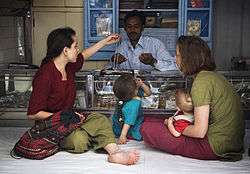
Silk weaving is the dominant industry in Varanasi.[102] Muslims are the influential community in this industry with nearly half a million of them working as weavers, dyers, sari finishers, and salespersons.[103] Weaving is typically done within the household, and most weavers are Momin Ansari Muslims.[104] Varanasi is known throughout India for its production of very fine silk and Banarasi saris, brocades with gold and silver thread work, which are often used for weddings and special occasions. The production of silk often uses bonded child labour, though perhaps not at a higher rate than elsewhere in India.[105] The silk weaving industry has recently been threatened by the rise of power looms and computer-generated designs and by competition from Chinese silk imports.[99] Trade Facilitation Centre is a modern and integrated facility to support the handloom and handicraft sector in Varanasi; providing trade enhancement and facilitation to both domestic & international buyers. Hence, carrying forward the rich traditions of handlooms and handicrafts.
In the metal manufacturing sector, Diesel Locomotive Works is a major employer.[101] Bharat Heavy Electricals, a large power equipment manufacturer, also operates a heavy equipment maintenance plant.[106] Other major commodities manufactured and traded in Varanasi include hand-knotted Mirzapur carpets, rugs, dhurries, brassware, copperware, wooden and clay toys, handicrafts, gold jewellery, and musical instruments.[102] Important agricultural products include betel leaves (for paan), langra mangoes and khoa (solidified milk).[101][107]
Tourism in Varanasi
Tourism is Varanasi's second most important industry.[108] Domestic tourist most commonly visit for religious purposes while foreign tourist visit for ghats along River Ganges and Sarnath. Most domestic tourists are from Bihar, West Bengal, Madhya Pradesh, and other parts of Uttar Pradesh, while the majority of foreign tourists are from Sri Lanka and Japan.[109] The peak tourist season falls between October and March.[109] In total, there are around 12,000 beds available in the city, of which about one half are in inexpensive budget hotels and one third in dharamsalas.[110] Overall, Varanasi's tourist infrastructure is not well developed.[110]
In 2017, InterContinental Hotels Group made an agreement with the JHV group to set up Holiday Inn and Crowne Plaza hotel chains in Varanasi.[111]
| Year | International | Domestic | Total |
|---|---|---|---|
| 2013 | 285,252 | 4,966,161 | 5,251,413 |
| 2014 | 287,761 | 5,202,236 | 5,489,997 |
| 2015 | 302,370 | 5,413,927 | 5,716,297 |
| 2016 | 312,519 | 5,600,146 | 5,912,665 |
| 2017 | 334,708 | 5,947,355 | 6,282,063 |
| 2018 | 348,970 | 6,095,890 | 6,444,860 |
| 2019 | 350,000 | 6,447,775 | 6,797,775 |
The prominent malls and multiplexes in Varanasi are JHV Mall in the Cantonment area, IP Mall in Sigra, IP Vijaya Mall in Bhelupur, Vinayak Plaza in Maldhaiya and PDR Mall in Luxa. The city has several banks, including the Allahabad Bank, Andhra Bank, Bank of Baroda, Canara Bank, Central Bank of India, Corporation Bank, Indian Overseas Bank, and State Bank of India.[114]
- DLW manufactured locomotives hauling load across the nation
Notable landmarks
Apart from the 19 archaeological sites identified by the Archaeological Survey of India,[115] some of the prominent places of interest are the Aghor Peeth, the Alamgir Mosque, the Ashoka Pillar, the Bharat Kala Bhavan (Art Museum), the Bharat Mata Mandir, the Central University for Tibetan Studies, the Dhanvantari Temple, the Durga Temple, the Jantar Mantar, the Kashi Vishwanath Temple, the Sankat Mochan Hanuman Temple, the Mahatma Gandhi Kashi Vidyapith, the Shri Vishwanath Temple on the BHU campus, the Ramnagar Fort, the Riverfront Ghats, the Tulsi Manas Temple.[116]
Jantar Mantar
The Jantar Mantar observatory, constructed in 1737, is located above the ghats along the Ganges, and is adjacent to the Manmandir and Dasaswamedh Ghats and near the palace of Jai Singh II of Jaipur. While less equipped than the observatories at Jaipur and Delhi, the Jantar Mantar has a unique equatorial sundial which is functional and allows measurements to be monitored and recorded by one person.[117]
Ramnagar Fort
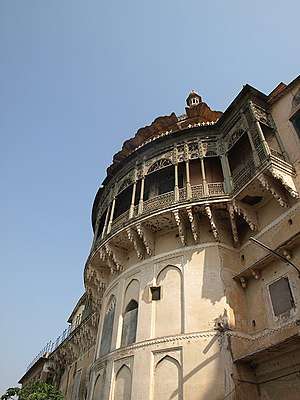
The Ramnagar Fort, located near the Ganges on its eastern bank and opposite the Tulsi Ghat, was built in the 18th century by Kashi Naresh Raja Balwant Singh with cream-coloured chunar sandstone. The fort is a typical example of the Mughal architecture with carved balconies, open courtyards, and scenic pavilions. At present, the fort is in disrepair. The fort and its museum are the repository of the history of the kings of Benares. Cited as an "eccentric" museum, it contains a rare collection of American vintage cars, bejewelled sedan chairs, an impressive weaponry hall, and a rare astrological clock.[118] In addition, manuscripts, especially religious writings, are housed in the Saraswati Bhawan which is a part of a museum within the fort. Many books illustrated in the Mughal miniature style are also part of the collections. Because of its scenic location on the banks of the Ganges, it is frequently used as an outdoor shooting location for films.[118][119]
Ghats
The Ghats in Varanasi are world-renowned embankments made in steps of stone slabs along the river bank where pilgrims perform ritual ablutions. The ghats are an integral complement to the Hindu concept of divinity represented in physical, metaphysical, and supernatural elements.[120] Varanasi has at least 84 ghats, most of which are used for bathing by pilgrims and spiritually significant Hindu puja ceremony, while a few are used exclusively as Hindu cremation sites.[121][122][123] Steps in the ghats lead to the banks of Ganges, including the Dashashwamedh Ghat, the Manikarnika Ghat, the Panchganga Ghat, and the Harishchandra Ghat, where Hindus cremate their dead. Many ghats are associated with Hindu legends and several are now privately owned.[124]
Many of the ghats were constructed under the patronage of the Marathas, Shindes (Scindias), Holkars, Bhonsles, and Peshwas. Most are bathing ghats, while others are used as cremation sites. A morning boat ride on the Ganges across the ghats is a popular tourist attraction. The extensive stretches of ghats in Varanasi enhance the riverfront with a multitude of shrines, temples, and palaces built "tier on the tier above the water's edge".[21]
The Dashashwamedh Ghat is the main and probably the oldest ghat of Varanasi located on the Ganges, close to the Kashi Vishwanath Temple. It is believed that Brahma created this ghat to welcome Shiva and sacrificed ten horses during the Dasa-Ashwamedha yajna performed there. Above and adjacent to this ghat, there are also temples dedicated to Sulatankesvara, Brahmesvara, Varahesvara, Abhaya Vinayaka, Ganga (the Ganges), and Bandi Devi, which are all important pilgrimage sites. A group of priests performs "Agni Pooja" (Sanskrit: "Worship of Fire") daily in the evening at this ghat as a dedication to Shiva, Ganga, Surya (Sun), Agni (Fire), and the entire universe. Special aartis are held on Tuesdays and on religious festivals.[122]
The Manikarnika Ghat is the Mahasmasana, the primary site for Hindu cremation in the city. Adjoining the ghat, there are raised platforms that are used for death anniversary rituals. According to a myth, it is said that an earring of Shiva or his wife Sati fell here. Fourth-century Gupta period inscriptions mention this ghat. However, the current ghat as a permanent riverside embankment was built in 1302 and has been renovated at least three times throughout its existence.[122]
The Jain Ghat is believed to birthplace of Suparshvanatha (7th Tirthankara) and Parshvanatha (23rd tirthankara). The Jain Ghat or Bachraj Ghat is a Jain Ghat and has three Jain Temples located on the banks of the River. It is believed that the Jain Maharajas used to own these ghats. Bachraj Ghat has three Jain temples near the river's banks, and one them is a very ancient temple of Tirthankara Suparswanath.
- Ghats in Varanasi

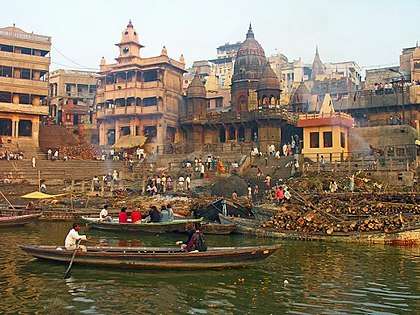
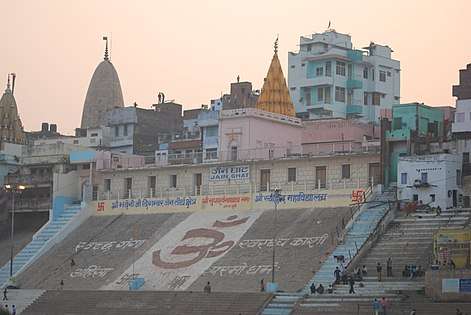 The Jain Ghat/Bachraj Ghat
The Jain Ghat/Bachraj Ghat
Temples
.jpg) The Kashi Vishwanath Temple, the most important temple in Varanasi.
The Kashi Vishwanath Temple, the most important temple in Varanasi.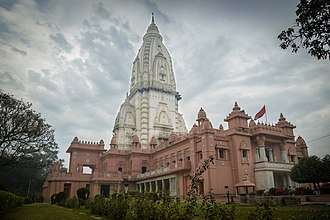 Shri Vishwanath Mandir has the tallest temple tower in the world.[125]
Shri Vishwanath Mandir has the tallest temple tower in the world.[125] The 18th century Durga Kund Temple, also known as the "Monkey temple".
The 18th century Durga Kund Temple, also known as the "Monkey temple".
Among the estimated 23,000 temples in Varanasi,[18] the temples most popular for worship are: the Kashi Vishwanath Temple of Shiva; the Sankat Mochan Hanuman Temple; and the Durga Temple, known for monkeys that reside in the large trees nearby.[42][126][13]
- The Kashi Vishwanath Temple, on the Ganges, is one of the 12 Jyotirlinga Shiva temples in Varanasi.[126] The temple has been destroyed and rebuilt several times throughout its existence. The Gyanvapi Mosque, which is adjacent to the temple, is the original site of the temple.[127] The temple, which is also known as the Golden Temple,[128] was built in 1780 by Queen Ahilyabai Holkar of Indore. The two pinnacles of the temple are covered in gold and were donated in 1839 by Ranjit Singh, the ruler of Punjab. The dome is scheduled to receive gold plating through a proposed initiative of the Ministry of Culture and Religious Affairs of Uttar Pradesh. Numerous rituals, prayers, and aartis are held daily at the temple between 02:30 and 23:00.[129]
- The Sankat Mochan Hanuman Temple, which is situated by the Asi River, is one of the sacred temples of the Hindu god Hanuman.[130] The present temple was built in the early 1900s by the educationist and Indian independence figure, Pandit Madan Mohan Malaviya, the founder of Banaras Hindu University.[131] According to Hindu legend the temple was built on the spot where the medieval Hindu saint Tulsidas had a vision of Hanuman.[132] During a 7 March 2006 terrorist attack, one of three explosions hit the temple while a wedding was in progress, and resulted in injuries to 30 people apart from 23 deaths.[131] Following the attack, a permanent police post was installed inside the temple.[133]
- There are two temples dedicated to the goddess Durga in Varanasi: Durga Mandir built in the 16th century (exact date not known), and Durga Kund (Sanskrit 'kund' meaning "pond or pool") built in the 18th century. A large number of Hindu devotees visit Durga Kund during Navratri to worship the goddess Durga. The temple, built in the Nagara architectural style, has multi-tiered spires[128] and is stained red with ochre, representing the red colour of Durga. The building has a rectangular tank of water called the Durga Kund ("Kund" meaning a pond or pool). During annual celebrations of Nag Panchami, the act of depicting the god Vishnu reclining on the serpent Shesha is recreated in the Kund.[134] While the Annapurna Temple, located nearby to the Kashi Vishwanath Temple, is dedicated to Annapoorna devi, the goddess of food,[126] the Sankatha Temple adjacent to the Sindhia Ghat is dedicated to Sankatha, the goddess of remedy. The Sankatha Temple has a large sculpture of a lion and a cluster of nine smaller temples dedicated to the nine planets.[126]
- Parshvanath Jain temple is the temple of Jain religion dedicated to Parshvanath, the 23rd Thirthankara who was born at Bhelpur in Varanasi. The idol deified in the temple is of black colour and 75 centimetres (30 inches) in height. It is located in Bhelapur about 5 kilometres (3.1 miles) from the centre of Varanasi city and 3 kilometres (1.9 miles) from the Benares Hindu University. It belongs to the Digambar sect of Jainism and is a holy tirtha or pilgrimage centre for Jains.
- Other temples of note are: the Bharat Mata Mandir, dedicated to the national personification of India, which was inaugurated by Mahatma Gandhi in 1936, the Kalabhairav Temple, the Mrithyunjay Mahadev Temple, and the New Vishwanath Temple located in the campus of BHU, the Tulsi Manas Mandir.[126]
Mosques
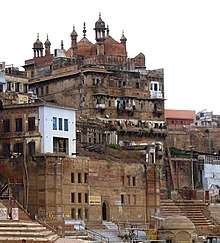
There are 15 mosques of significant historical value in Varanasi. Of particular note are the Abdul Razzaq, Alamgir, Bibi Razia, Chaukhambha, Dhai Nim Kangore, Fatman, Ganje Shahada, Gyanavapi, and Hazrat Sayyed Salar Masud Dargah. Many of these mosques were constructed from the components of the Hindu shrines which were destroyed under the auspices of subsequent Muslim invaders or rulers. The two well known mosques are the Gyanvapi Mosque and the Alamgir Mosque.[135]
The Gyanvapi Mosque was built by the Mughal emperor Aurangzeb in 1664 CE, after destroying a Hindu temple.[136] Gyan Vapi (Sanskrit: "the well of knowledge"), the name of the mosque, is derived from a well of the same name located within the precincts of the mosque.[137] The remains of an erstwhile temple can be seen in the foundation, the columns and at the rear part of the mosque [138] The façade of the mosque is modelled partially on the Taj Mahal's entrance.[139] The mosque is administered by the Anjuman Inthazamiya Masajid (AIM).[140]
The Alamgiri Mosque was built in the 17th century by Aurangzeb over the ruins of a Hindu temple.[141] The Hindu temple that was destroyed was dedicated to Vishnu, and had been built by Beni Madhur Rao Scindia, a Maratha chieftain. When emperor Aurangzeb had captured Banaras, he had ordered total destruction of all Hindu temples there. Aurangzeb then built a mosque over the ruins of this temple in 1669[142] and named it as Alamagir Mosque in the name of his own honorific title "Alamgir" which he had adopted after becoming the emperor of Mughal empire.[143][144] The mosque is located at a prominent site above the Panchganga Ghat, which is a funerary ghat facing the Ganges.[145] The mosque is architecturally a blend of Islamic and Hindu architecture, particularly because of the lower part of the walls of the mosque having been built fully with the remains of the Hindu temple.[143] The mosque has high domes and minarets.[146][144] Two of its minarets had been damaged; one minaret crashed killing a few people and the other minaret was officially brought down because of stability concerns.[144] Non-Muslims are not allowed to enter the mosque.[147] The mosque has a security cordon of a police force.[148]
Shri Guru Ravidass Janam Asthan
Shri Guru Ravidass Janam Asthan, at Sir Gobardhan is the ultimate place of pilgrimage or religious headquarters for followers of the Ravidassia religion.[149] The foundation stone was laid on 14 June 1965 on Ashad Sankranti day at the birthplace of Ravidas. The temple was completed in 1994.[150]
Sarnath
Sarnath is located 10 kilometres north-east of Varanasi near the confluence of the Ganges and the Varuna rivers in Uttar Pradesh, India. The deer park in Sarnath is where Gautama Buddha first taught the Dharma, and where the Buddhist Sangha came into existence through the enlightenment of Kondanna.[151]
The city is mentioned by the Buddha as one of the four places of pilgrimage to which his devout followers should visit. It was also the site of the Buddha's Dhammacakkappavattana Sutta, which was his first teaching after attaining enlightenment, in which he taught the four noble truths and the teachings associated with it.[151]
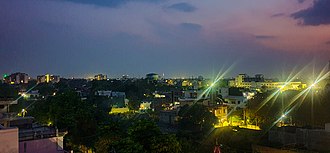
Culture
Literature
Renowned Indian writers who have resided in the city were Kabir, Ravidas, and Tulsidas, who wrote much of his Ram Charit Manas here. Kulluka Bhatt wrote the best known account of Manusmriti in Varanasi in the 15th century. The Cakkavatti Sīhanāda Sutta text of Buddhism puts forth an idea stating that Varanasi will one day become the fabled kingdom of Ketumati in the time of Maitreya.[152] Later writers of the city have included Acharya Shukla, Baldev Upadhyaya, Bharatendu Harishchandra, Devaki Nandan Khatri, Hazari Prasad Dwivedi, Jaishankar Prasad, Kshetresa Chandra Chattopadhyaya, Sudama Pandey (Dhoomil), Vagish Shastri, and Vidya Niwas Mishra.
Several newspapers and journals are or were published in Varanasi such as Varanasi Chandroday and its successor Kashivartaprakashika, which became a weekly journal, first published on 1 June 1851.[153] The main newspaper is Aj, a Hindi-language nationalist newspaper first published in 1920.[154] The newspaper was the bulwark of the Indian National Congress and is a major newspaper of Hindi northern India.[154]
Art
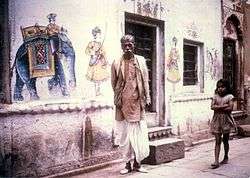
Varanasi is a major centre of arts and designs. It is a producer of silks and brocades with gold and silver thread work, carpet weaving, wooden toys, bangles made of glass, ivory work, perfumes, artistic brass and copper ware and a variety of handicrafts.[155][156] The cantonment graveyard of the British Raj is now the location of Varanasi's Arts and Crafts.[157]
Notable artists (musicians and dancers) and historians who are connected with the city include Bismillah Khan, Ravi Shankar, Girija Devi, Gopal Shankar Misra, Gopi Krishna, Kishan Maharaj, Lalmani Misra, N. Rajam, Siddheshwari Devi, Samta Prasad, and Sitara Devi.[158]
Music
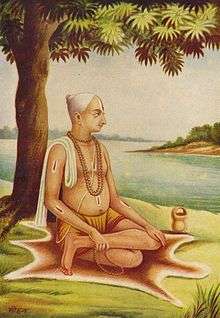
Varanasi's music tradition is traced to the Pauranic days. According to ancient legend, Shiva is credited with evolving music and dance forms. During the medieval era, Vaishnavism, a Bhakti movement, grew in popularity, and Varanasi became a thriving center for musicians such as Surdas, Kabir, Ravidas, Meera and Tulsidas. During the monarchic rule of Govind Chandra in the 16th century, the Dhrupad style of singing received royal patronage and led to other related forms of music such as Dhamar, Hori, and Chaturang. Presently the Dhrupad maestro Pandit Ritwik Sanyal from Varanasi is working for the revival of this art-music.[159]
In recent times, Girija Devi, the native famous classical singer of thumris, was widely appreciated and respected for her musical renderings.[160] Varanasi is also associated with many great instrumentalists such as Bismillah Khan[159] and Ravi Shankar, the famous sitar player and musicologist who was given the highest civilian award of the country, the Bharat Ratna.[161] Varanasi has joined the global bandwagon of UNESCO "Cities of Music" under the Creative Cities Network.[162]
Festivals
On Maha Shivaratri (February), a procession of Shiva proceeds from the Mahamrityunjaya Temple to the Kashi Vishwanath Temple.[42] Dhrupad Mela is a five-day musical festival devoted to dhrupad style held at Tulsi Ghat in February–March.[163] The Sankat Mochan Hanuman Temple celebrates Hanuman Jayanti (March–April), the birthday of Hanuman. A special puja, aarti, and a public procession is organised.[164][165] Since 1923, the temple has organised a five-day classical music and dance concert festival named Sankat Mochan Sangeet Samaroh, wherein iconic artists from all parts of India are invited to perform.[42]
The Ramlila of Ramnagar is a dramatic enactment of Rama's legend, as told in Ramacharitamanasa.[40] The plays, sponsored by Kashi Naresh, are performed in Ramnagar every evening for 31 days.[40] On the last day, the festivities reach a crescendo as Rama vanquishes the demon king Ravana.[40] Kashi Naresh Udit Narayan Singh started this tradition around 1830.[40]
Nag Nathaiya is celebrated on the fourth lunar day of the dark fortnight of the Hindu month of Kartik (October–November). It commemorates the victory of Krishna over the serpent Kaliya. On this occasion, a large Kadamba tree (Neolamarckia cadamba) branch is planted on the banks of the Ganges so that a boy, playing the role of Krishna, can jump into the river on to the effigy representing Kaliya. He stands over the effigy in a dancing pose playing the flute, while an audience watches from the banks of the river or from boats.[166] Bharat Milap celebrates the meeting of Rama and his younger brother Bharata after the return of the former after 14 years of exile.[42] It is celebrated during October–November, a day after the festival of Vijayadashami. Kashi Naresh attends this festival in his regal attire. The festival attracts a large number of devotees.[167]
Ganga Mahotsav is a five-day music festival organised by the Uttar Pradesh Tourism Department, held in November–December. It culminates a day before Kartik Purnima, also called the Ganges festival. On this occasion the Ganges is attended by thousands of pilgrims, release lighted lamps to float in the river from the ghats.[42][163]
The primary Muslim festivals celebrated annually in the city are the ld-ul-fitr' (Ramzan), Bakrid, Mid-Sha'ban, Bara Wafat and Muharram. Additional festivals include Alvida and Chehlum. A non-religious festival observed by Muslims is Ghazi-miyan-ka-byaha ("the marriage of Ghazi Miyan").[168][169]
Education

Historically, Varanasi has been a centre for education in India, attracting students and scholars from across the country.[170][171] Varanasi has an overall literacy rate of 80% (male literacy: 85%, female literacy: 75%).[92] It is home to a number of colleges and universities. Most notably, it is the site of Banaras Hindu University (BHU), which is one of the largest residential universities in Asia with over 20,000 students.[172] The Indian Institute of Technology (BHU) Varanasi is designated an Institute of National Importance and is one of 16 Indian Institutes of Technology. Other colleges and universities in Varanasi include Jamia-e-Imania, the Institute of Integrated Management and Technology, Mahatma Gandhi Kashi Vidyapith, Nav Sadhana Kala Kendra, Sampurnanand Sanskrit University, Sri Agrasen Kanya P.G. College, and Udai Pratap Autonomous College. Various engineering colleges have been established in the outskirts of the city. Other notable universities and colleges include Institute of Medical Sciences, Sampurnanand Sanskrit Vishwavidyalaya, Central Institute of Higher Tibetan Studies, Harish Chandra Postgraduate College, and School of Management Sciences. Some research oriented institutes were also established by the government such as International Rice Research Institute (IRRI),[173] Indian Institute of Vegetable Research[174] and National Seed Research and Training Centre.[175] Varanasi also has three Kendriya Vidyalaya. Among them Kendriya Vidyalaya BHU holds the regional office of Varanasi Region of KVS and is seat of Deputy Commissioner. Kendriya Vidyalaya BHU is also accredited by the British Council. Other KVs are Kendriya Vidyalaya 39 GTC and Kendriya Vidyalaya DLW.
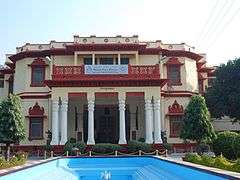
St. Joseph's Convent School, in Shivpur, Varanasi, was established by the Sisters of Our Lady of Providence of France as a Catholic (Christian) minority institution with the approval of the Government of Uttar Pradesh. It is an autonomous organisation under the diocese of the Bishop of Varanasi. It provides education not only to the Catholic Christian children, but also to others who abide by its rules.[176]
Another important institution is the Central Hindu School in Kamachha. This was established by Annie Besant in July 1898 with the objective of imparting secular education. It is affiliated to the Central Board of Secondary Education and is open to students of all cultures.[177][178]
Schools in Varanasi are affiliated with the Indian Certificate of Secondary Education (ICSE), the CBSE, or the Uttar Pradesh Board of Technical Education (U.P Board). The overall "state of education in Varanasi is ... not good."[179] Schools in Varanasi vary widely in quality, with private schools outperforming government schools.[179] In government schools, many teachers fail to come to class or to teach children.[179] Some government schools lack basic equipment, such as blackboards and sufficient desks and chairs for all students.[179] Private schools vary in quality, with the most expensive conducting lessons in English (seen as a key to children's success) and having computers in classrooms.[179] Pupils attending the more expensive private schools, tended to come from upper-class families.[179] Lower-cost private schools attracted children from lower-income families or those lower-income families with higher education aspirations.[179] Government schools tend to serve lower-class children with lower education aspirations.[179]
Media
Varanasi caters a lot of shooting from different film industries in India.[180] The temple town has emerged as a hub to Hindi film industry and South film industry.[181] Also, a chunk of Bhojpuri movies are shot in the city.[182] A few Bollywood movies that were shot, include Gangs of Wasseypur, Raanjhanaa, Piku, Shubh Mangal Zyada Saavdhan and Super 30.[183][184][185][186][187] Some parts of the Hollywood movie The Curious Case of Benjamin Button were also shot.[188] Web series such as Mirzapur and Asur were also shot in temple town.[189][190]
Newspapers are widely available in Hindi and English. Aj, Hindi newspaper was established in 1920 in Varanasi.[191] Some publishers in the city are:
- Dainik Jagran[192]
- Hindustan[193]
- Amar Ujala[194]
- Jansandesh Times[195]
- Rajasthan Patrika[196]
- Aj[191]
- Times of India[197]
- Hindustan Times[198]
The city also hosts a Doordarshan Kendra, which was established in 1984 by the Hon'ble Prime Minister of India late Smt. Indira Gandhi. In 1998, Doordarshan studio was setup.[199]
FM/AM Stations available in the city are:[200][201][202]
- Radio City 91.9 MHz
- Red FM 93.5 MHz
- BIG FM 95.0 MHz
- Radio Mirchi 98.3 MHz
- Radio Sunbeam 90.4 MHz
- AIR Vividh Bharati 100.6 MHz
- Gyan Vani 105.6 MHz
- AIR Varanasi 1242 AM
Mobile apps such as "InVaranasi", "Varanasi" and "LiveVNS" provide a wide range of information related to travel and local news.[203][204][205]
Sport
Basketball, cricket, and field hockey are popular sports in Varanasi.[206] The main stadium in the city is the Dr Sampurnanda Stadium (Sigra Stadium), where first-class cricket matches are held.[207] The city also caters an AstroTurf hockey stadium named, Dr. Bheemrao Ambedker National Hockey Stadium.[208]
The Department of Physical Education, Faculty of Arts of BHU offers diploma courses in Sports Management, Sports Physiotherapy, Sports Psychology and Sports Journalism.[209] Also, BHU caters sports complexes including badminton court, tennis court, swimming pool and amphitheater.[210]
Gymnastics is also popular in Varanasi, and many Indian girls practice outdoors at the ghats in the mornings which hosts akhadas, where "morning exercise, a dip in the Ganges and a visit to Lord Hanuman" forms a daily ritual.[211] Despite concerns regarding water quality, two swimming clubs offer swimming lessons in the Ganges.[212]
The Varanasi District Chess Sports Association (VDCSA) is based in Varanasi, affiliated to the regional Uttar Pradesh Chess Sports Association (UPCSA).[213]
Transport
Varanasi is well-connected by air, rail, and road. One of the major factors in Varanasi, is its access to all parts of the country. Within the city mobility is provided by taxis, rickshaws, cycle rickshaws, and three-wheelers, but with certain restrictions in the old town area of the city.[214]
Air transport

Varanasi is served by Lal Bahadur Shastri International Airport (IATA: BNS, ICAO: VEBN), which is approximately 26 km (16 mi) from the city centre in Babatpur.[215] The airport's new terminal was inaugurated in 2010, and it was granted international airport status on 4 October 2012.[216][217] Air India, Air India Express, Buddha Air, IndiGo, Malindo Air, SpiceJet, SriLankan Airlines, Thai AirAsia, Thai Smile and Vistara operate flights from Varanasi to Ahmedabad, Bangkok, Colombo, Delhi, Gaya, Kathmandu, Khajuraho, Sharjah, Kuala Lumpur, Mumbai, Hyderabad, Bengaluru, Goa, Guwahati, Jaipur, Kolkata and several other cities.[218]
Over 3,010,702 passengers passed through the airport in 2019–20, making it the 20th busiest airport in India. The total aircraft movement for the session 2019-20 was 24,056 while cargo tonnage equalled 3,580. Total footfall of the international passengers for the session 2019-20 was 231,730.[219][220][221]
Railways
Varanasi Junction, commonly known as Varanasi Cantt Railway Station, is the city's largest train station. More than 360,000 passengers and 240 trains pass through each day.[222] Manduadih railway station is also a Terminal station of Varanasi. Because of huge rush at Varanasi Junction the railway developed the station as a high facilitated terminal.Varanasi City railway station is also one of the railway stations in Varanasi district. It is 4 km North-East of Varanasi Junction railway station. It serves as Terminal station because of heavy rush at Varanasi Junction. Mughalsarai Junction railway station is also the important station in Varanasi suburban.
Some important express trains operating from the Varanasi Junction railway station and Manduadih railway station are: Shiv Ganga Express runs between New Delhi Junction and Manduadih station while Mahamana Express runs between Varanasi junction and New Delhi Junction; the Udhna Varanasi Express that runs between Udhna (Surat) junction and Varanasi, a distance of 1,398 kilometres (869 mi);[223] the Kashi Vishwanath Express that runs between Varanasi and New Delhi railway station;[224] the Kanpur Varanasi InterCity express, also called Varuna express, which runs over a distance of 355 kilometres (221 mi) and connects with Lucknow (the capital city of Uttar Pradesh) and Varanasi;[225] and the Sabarmati Express which runs between Varanasi and Ahmedabad. Vande Bharat Express, a semi-high speed train was launched in the month of February in 2019 in the Delhi-Varanasi route.[226] The train reduced the time travel between the two cities by 15 percent as compared to the Shatabdi Express.[227]

Varanasi has following railway stations within the city suburbs:[228][229]
| Station Name | Station Code | Railway Zone | Number of Platforms |
|---|---|---|---|
| Varanasi Junction | BSB | Northern Railway | 9 |
| Manduadih Railway Station | MUV | North Eastern Railway | 8 |
| Varanasi City Railway Station | BCY | North Eastern Railway | 5 |
| Kashi Railway Station | KEI | Northern Railway | 3 |
| Sarnath Railway Station | SRNT | North Eastern Railway | 3 |
| Deen Dayal Upadhyaya Junction | DDU | East Central Railway | 8 |
| Shivpur Railway Station | SOP | Northern Railway | 3 |
| Bhulanpur Railway Station | BHLP | Northern Railway/North Eastern Railway | 2 |
| Lohta Railway Station | LOT | Northern Railway | 3 |
Roads
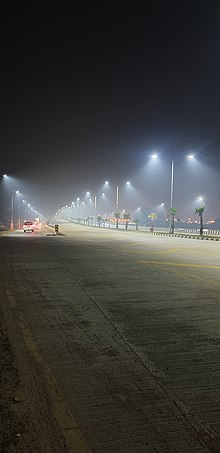
Auto rickshaws and E-rickshaws are the most widely available forms of public transport in the old city.[230] In the outer regions of the city, taxis are available.[230] Daily commuters prefer city buses, which operate on specific routes of urban and suburban areas. The city buses are operated by Varanasi City Transport Service Limited.[231] Nearly, 120 buses are operated by Varanasi City Transport Service Limited.[232]
The following National Highways pass through Varanasi:[233][234][235][236][237]
| National Highway | Route | Total Length |
|---|---|---|
| NH 19 | Delhi » Mathura » Agra » Kanpur » Allahabad » Varanasi » Mohania » Barhi » Palsit » Kolkata | 1323 km |
| NH 233 | Varanasi » Azamgarh » Tanda » Basti » Siddharthnagar » Lumbini (Nepal) | 288 km |
| NH 35 | Mahoba » Banda » Chitrakoot » Allahabad » Mirzapur » Varanasi | 346 km |
| NH 31 | Unnao » Raebareli » Pratapgarh » Varanasi » Patna » Samsi | 968 km |
| NH 7 | Varanasi » Jabalpur » Nagpur » Hyderabad » Bangalore » Kanyakumari | 2369 km |
The heavy traffic of the city is monitored through Integrated Traffic Management System. The smart traffic management system equips the city with automatic signal control system, separate signal system for pedestrians, traffic management center at state level, area traffic control system, corridor management and dynamic traffic indicators for smooth movement of traffic.[238] Varanasi Traffic Police keeps an eye through Smart Command and Control Centre.[239][240]
- Road in Varanasi Cantonment
Inland Waterways
National Waterway 1 passes through Varanasi. In 2018, a new inland port was established on the banks of Ganges River.[241] The Multi-Modal Terminal is designed to handle 1.26 million metric tons of cargo every year and covers an area of 34 hectares.[242] Nearly, 170 crore was invested by the Government to setup an inland port.[243] Maersk started its container service in 2019 by moving 16 containers on NW-1 from Varanasi to Kolkata. The port also catered PepsiCo, IFFCO Fertilizers, Emami Agrotech and Dabur for cargo movement.[244]
Projects
Due to growing population and industrial demands, the city is being implanted with several infrastructural projects.[245] In fiscal year 2014–18, the city was awarded with projects worth Rs 30,000 crore.[246] The city is being invested by both private and public playerst in different sectors.[247] Currently, there are many undergoing projects and many have been planned.
Road
The Government is executing seven road projects connecting Varanasi, the total project cost being Rs 71 billion and the total length of the project being 524 km. Some important projects are:
- Six lane Varanasi-Aurangabad section of NH-19[248]
- Six lane Varanasi-Allahabad NH-19[249]
- Four lane Varanasi-Gorakhpur NH-29[250]
- Ghagra Bridge-Varanasi section of NH-233[248]
- Four lane Varanasi-Azamgarh Section NH-233[251]
- Four lane Varanasi-Sultanpur NH-56[252]
- New four lane Varanasi-Ayodhya Highway[253]
- Varanasi Ring Road Phase - 2[254]
- Ganga Expressway Phase - 2[255]
- Varanasi-Ranchi-Kolkata Greenfield Expressway[256]
- Purvanchal Link Expressway[257]
Railways
In 2018, the budget reflected undergoing rail projects of worth Rs 4500 crore. Some important projects are:[258]
- 3rd rail line between Varanasi-Mughalsarai[259]
- New Delhi-Varanasi High Speed Rail Corridor[260]
- Eastern Dedicated Freight Corridor (Jeonathpur Railway Station)[261]
- Kashi Railway Station to be developed as Intermodal Station (IMS)[262][263]
Airport
Varanasi Metro
The Varanasi Metro is a rapid transit proposed for Varanasi. The proposed system consists of two lines, spanning from BHEL to Banaras Hindu University (19.35 km) and Benia Bagh to Sarnath (9.885 km). The feasibility study of the project was done by RITES and was completed in June 2015. Metro Rail is likely to be completed around 2020. There will be 26 stations, including 20 underground and six elevated on the two lines, which includes total length of 29.235 km consisting of 23.467 km underground, while 5.768 km will be elevated.[266][267][268][269]
The total estimated completion cost for construction of Varanasi Metro is estimated to be Rs. 13,133 crore.[270] The project is envisaged to be undertaken as a joint venture (JV) project between the Government of India (GoI) and the Government of Uttar Pradesh (GoUP) with 50:50 equity partnerships. To maintain the financial viability of the project, additional grants have been proposed from the two governments in addition to their equity contribution.
Sister cities
See also
References
Citations
- "Varanasi: About the city". Official website of Uttar Pradesh Tourism. Archived from the original on 8 July 2013. Retrieved 23 May 2013.
- "District Census Handbook Varanasi" (PDF).
- "Urban Agglomerations/Cities having population 1 lakh and above" (PDF). Office of the Registrar General & Census Commissioner, India. Archived (PDF) from the original on 17 October 2013. Retrieved 12 May 2014.
- "52nd REPORT OF THE COMMISSIONER FOR LINGUISTIC MINORITIES IN INDIA" (PDF). nclm.nic.in. Ministry of Minority Affairs. Archived from the original (PDF) on 25 May 2017. Retrieved 26 December 2018.
- "Yogi Adityanath is right. Route to UP's $1 trillion GDP goal passes through hinterland". Retrieved 25 September 2019.
- "Executive Summary" (PDF). Retrieved 29 December 2019.
- "Slum Free City Plan of Action Varanasi" (PDF).
- http://ssca.org.in/media/4_2016_HDI_t1hcMZm.pdf
- The name that appears on the 1909 version official map of India
- "When the spirit of Kabir took over the ancient ghats of Benares". The Sunday Guardian Live. 30 November 2019. Retrieved 29 December 2019.
- Kapoor, Punkhuri (25 March 2017). "Kashi's Mehta Hospital likely to get facelift | Varanasi News - Times of India". The Times of India. Retrieved 29 December 2019.
- Romita Saluja (18 June 2019). "India's City Where People Come to Die". BBC.
- Cunningham & Sastri 2002, pp. 131–140.
- Eck 1982, p. 10, 58, refers to "Banares – which Hindus call Kashi, the City of Light" (p. 10) and "Hindus call it Kashi, the luminous City of Light" (p. 58)..
- Talageri, Shrikant G. "The Geography of the Rigveda". Archived from the original on 10 August 2011. Retrieved 4 February 2007.
- Melton 2007, p. 29.
- Edward Sachau, 1910, Alberuni's India Archived 3 March 2018 at the Wayback Machine, p. 147, London: Kegan Paul, Trench, Trubner & Co. Ltd.
- Bansal 2008, pp. 48–49.
- "Garuḍa Purāṇa XVI 114". Archived from the original on 26 October 2012. Retrieved 9 November 2012.
- "Banaras (Inde): new archaeological excavations are going on to determine the age of Varanasi". Archived from the original on 25 July 2014. Retrieved 22 May 2014.
- Pletcher 2010, pp. 159–160.
- Herman 1999, p. 153.
- Melton & Baumann 2010, p. 2536.
- Berwick 1986, p. 121.
- Eck 1982, p. 57.
- Bindloss, Brown & Elliott 2007, p. 278.
- Sen, Sailendra (2013). A Textbook of Medieval Indian History. Primus Books. pp. 32–33. ISBN 978-9-38060-734-4.
- Indian History. Allied Publishers. 2010. p. A-304. ISBN 978-81-8424-568-4.
- Singh, Pradyuman. Bihar General Knowledge Digest. ISBN 9789352667697.
- Das 1991, p. 17.
- Merriam-Webster 1999, p. 910.
- Gandhi 2007, p. 90.
- Mitra 2002, p. 182.
- Prakash 1981, p. 170.
- Schreitmüller 2012, p. 284.
- Corp 2007, p. 1.
- Kochhar 2015, p. 247.
- Twain 1897, p. Chapter L.
- "A review of Varanasi". Blonnet.com. Archived from the original on 24 September 2009. Retrieved 3 November 2012.
- Mitra 2002, p. 216.
- Sharma & Sharma 2001, p. 197.
- "Varanasi". Encyclopædia Britannica. Archived from the original on 10 August 2011. Retrieved 11 August 2009.
- "DEO Varanasi". Tourist Information: General Information. Varanasi District Administration by National Informatics center. Archived from the original on 28 June 2011.
- Mohanty 1993, p. 316.
- Maps (Map). Google Maps.
- Singh, Rana P.B. "Varanasi as Heritage City (India) on the scale the UNESCO World Heritage List: From Contestation to Conservation" (PDF). EASAS papers. Swedish South Asian Studies Network. Archived from the original (PDF) on 10 August 2011. Retrieved 18 August 2006.
- "Indo-Gangetic Plain". Encyclopaedia Britannica. Retrieved 26 December 2018.
- Kishore 2008, p. 65.
- Singh 1975, p. 4.
- Pandey 1989, p. 13.
- Singh & Rana 2002, p. 27.
- "Is River Ganges drying in Varanasi". Aninews.in. Archived from the original on 12 May 2012. Retrieved 3 November 2012.
- "Ganges receding despite rainfall". The Australian. 1 June 2011.
- "Climatological Normals 1981–2010" (PDF). India Meteorological Department. January 2015. pp. 779–782. Archived from the original (PDF) on 5 February 2020. Retrieved 1 March 2020.
- "Extremes of Temperature & Rainfall for Indian Stations (Up to 2012)" (PDF). India Meteorological Department. December 2016. p. M224. Archived from the original (PDF) on 5 February 2020. Retrieved 1 March 2020.
- "Table 3 Monthly mean duration of Sun Shine (hours) at different locations in India" (PDF). Daily Normals of Global & Diffuse Radiation (1971–2000). India Meteorological Department. December 2016. p. M-3. Archived from the original (PDF) on 5 February 2020. Retrieved 1 March 2020.
- "CONSTITUTIONAL SETUP". Government of Uttar Pradesh. Archived from the original on 31 August 2017. Retrieved 30 August 2017.
- Maheshwari, S.R. (2000). Indian Administration (6th ed.). New Delhi: Orient Blackswan Private Ltd. pp. 563–572. ISBN 9788125019886.
- Singh, G.P. (1993). Revenue administration in India: A case study of Bihar. Delhi: Mittal Publications. pp. 26–129. ISBN 978-8170993810.
- Laxmikanth, M. (2014). Governance in India (2nd ed.). Noida: McGraw Hill Education. pp. 5.1–5.2. ISBN 978-9339204785.
- "Role and Functions of Divisional Commissioner". Your Article Library. 6 January 2015. Archived from the original on 16 August 2017. Retrieved 20 August 2017.
- "Contact Details Of Commissioners and District Magistrates Of U.P." Department of Home and Confidential, Government of Uttar Pradesh. Archived from the original on 16 August 2017. Retrieved 15 August 2017.
- जिलाधिकारी/मंडलायुक्त की सूची [List of District Magistrates and Divisional Commissioners]. Department of Appointments and Personnel, Government of Uttar Pradesh (in Hindi). Archived from the original on 11 July 2017. Retrieved 15 August 2017.
- "Contact us" (PDF). Varanasi District website. Archived (PDF) from the original on 21 August 2017. Retrieved 21 August 2017.
- Maheshwari, S.R. (2000). Indian Administration (6th ed.). New Delhi: Orient Blackswan Private Ltd. pp. 573–597. ISBN 9788125019886.
- Laxmikanth, M. (2014). Governance in India (2nd ed.). Noida: McGraw Hill Education. pp. 6.1–6.6. ISBN 978-9339204785.
- Singh, G.P. (1993). Revenue administration in India: A case study of Bihar. Delhi: Mittal Publications. pp. 50–124. ISBN 978-8170993810.
- "Powers Of District Magistrate in India". Important India. Archived from the original on 16 August 2017. Retrieved 20 August 2017.
- "Officers posted at Varanasi Zone". Uttar Pradesh Police. Archived from the original on 21 August 2017. Retrieved 16 August 2017.
- "Officers posted at Varanasi Range". Uttar Pradesh Police. Archived from the original on 21 August 2017. Retrieved 16 August 2017.
- "Officers posted at VARANASI". Uttar Pradesh Police. Archived from the original on 3 March 2018. Retrieved 16 August 2017.
- "VDA Board Members". Varanasi Development Authority (in Hindi). Archived from the original on 21 August 2017. Retrieved 16 August 2017.
- "List of IAS officers who are Vice Chairman of Development Authorities". Department of Appointment and Personnel, Government of Uttar Pradesh. Archived from the original on 21 August 2017. Retrieved 21 August 2017.
- "PCS OFFICERS (Posted as HOD)". Department of Appointment and Personnel, Government of Uttar Pradesh. Archived from the original on 21 August 2017. Retrieved 21 August 2017.
- Academy, p. 21.
- "Elections 2014: Narendra Modi wins Varanasi by a massive margin of 3.37 lakh votes". The Economic Times. 16 March 2014.
- "Annual Health Survey 2010–2011" Archived 7 February 2013 at the Wayback Machine (11 mb PDF). Office of the Registrar General & Census Commissioner, India (2011).
- "Tata Memorial will run railways' cancer hospital in Varanasi".
- Susruta Archived 9 April 2008 at the Wayback Machine The Imperial Gazetteer of India, 1909, v. 2, p. 570.
- "faculty of Ayurveda". Banaras Hindu University. Archived from the original on 2 March 2015.
- "Sparsa Ayurvedic Centre". ayurveda.in. Archived from the original on 11 July 2015.
- Mohanty 1993, p. 316-7.
- Mohiuddin, Yasmeen (2010). "News | The Forum on Religion and Ecology at Yale". fore.yale.edu. Archived from the original on 18 October 2015. Retrieved 4 August 2015.
- Hamner, Steve; Tripathi, Anshuman; Mishra, Rajesh Kumar; Bouskill, Nik; Broadaway, Susan C.; Pyle, Barry H.; Ford, Timothy E. (2006). "The role of water use patterns and sewage pollution in incidence of water-borne/enteric diseases along the Ganges river in Varanasi, India". International Journal of Environmental Health Research. 16 (2): 113–132. doi:10.1080/09603120500538226. ISSN 0960-3123. PMID 16546805. S2CID 23264273.
- Sharma, Rajesh Kumar; Agrawal, Madhoolika; Marshall, Fiona M. (2008). "Heavy metal (Cu, Zn, Cd and Pb) contamination of vegetables in urban India: A case study in Varanasi". Environmental Pollution. 154 (2): 254–263. doi:10.1016/j.envpol.2007.10.010. ISSN 0269-7491. PMID 18031880.
- Sharma, R. K.; Agrawal, M.; Marshall, F. (2006). "Heavy Metal Contamination in Vegetables Grown in Wastewater Irrigated Areas of Varanasi, India". Bulletin of Environmental Contamination and Toxicology. 77 (2): 312–318. doi:10.1007/s00128-006-1065-0. ISSN 0007-4861. PMID 16977535. S2CID 26864659.
- Kumar Sharma, Rajesh; Agrawal, Madhoolika; Marshall, Fiona (2007). "Heavy metal contamination of soil and vegetables in suburban areas of Varanasi, India". Ecotoxicology and Environmental Safety. 66 (2): 258–266. doi:10.1016/j.ecoenv.2005.11.007. ISSN 0147-6513. PMID 16466660.
- Singh, Kunwar P; Mohan, Dinesh; Sinha, Sarita; Dalwani, R (2004). "Impact assessment of treated/untreated wastewater toxicants discharged by sewage treatment plants on health, agricultural, and environmental quality in the wastewater disposal area". Chemosphere. 55 (2): 227–255. Bibcode:2004Chmsp..55..227S. doi:10.1016/j.chemosphere.2003.10.050. ISSN 0045-6535. PMID 14761695.
- Bhargava, Gopal (25 October 2000). "Scheme for Varanasi". The Tribune. India. Archived from the original on 12 September 2006.
- "Waste Generation and Composition". Management of municipal solid wastes. Planning Division, Central Pollution Control Board. Archived from the original on 17 July 2006. Retrieved 18 August 2006.
- "Status of landfill sites in 59 cities". Management of municipal solid wastes. Planning Division, Central Pollution Control Board. Archived from the original on 17 July 2006. Retrieved 18 August 2006.
- "Urban Agglomerations/Cities having population 1 lakh and above" (PDF). Provisional Population Totals, Census of India 2011. Archived (PDF) from the original on 13 November 2011. Retrieved 7 July 2012.
- "Urban Agglomerations/Cities having population of more than one million in 2001". Census of India 2001 (Provisional). Office of the Registrar General, India. 25 July 2001. Archived from the original on 23 December 2006. Retrieved 18 August 2006.
- "Population, Population in the age group 0–6 and literates by sex – Urban Agglomeration/Town: 2001" (PDF). Census of India 2001 (Provisional). Office of the Registrar General, India. pp. 53–54. Archived from the original on 23 December 2006. Retrieved 17 August 2006.
- "Slum Population in Million Plus Cities (Municipal Corporations): Part A". Census of India 2001 (Provisional). Office of the Registrar General, India. 22 January 2002. Archived from the original on 23 December 2006. Retrieved 18 August 2006.
- "Population By Religious Community".
- Jacobsen 2013, p. 136.
- Singh 2009, p. 32.
- JNNURM 2006, p. 29.
- JNNURM 2006, p. 28.
- JNNURM 2006, p. 31.
- JNNURM 2006, p. 29-31.
- Warikoo 2010, p. 192.
- Wood 2011, p. 113.
- Human Rights Watch 1996, p. 82.
- "About Bharat". Bharat Heavy Electricals Limited. Archived from the original on 11 June 2012. Retrieved 3 November 2012.
- Mitra 2002, p. 117, 169.
- JNNURM 2006, p. 57.
- JNNURM 2006, p. 56.
- JNNURM 2006, p. 58.
- Chaturvedi, Anumeha (12 December 2017). "IHG debuts in Varanasi with Holiday Inn and Crowne Plaza hotels". The Economic Times.
- "ANNUAL TOURIST VISITS STATISTICS- 2013, 2014, 2015, 2016, 2017" (PDF). UP Tourism.
- "The Indian and Foreign tourist visits in important tourist places of Uttar Pradesh in year 2015 to 2019" (PDF).
- "Bank, Post & Telegraph". Uttar Pradesh Tourism. Archived from the original on 30 October 2012. Retrieved 30 October 2012.
- "Alphabetical List of Monuments – Uttar Pradesh". Archaeological Survey of India. Archived from the original on 8 May 2012. Retrieved 22 October 2012.
- "DEO Varanasi". Tourist Information:Places of Interest. Varanasi District Administration by National Informatics center. Archived from the original on 28 June 2011.
- "18th Century Observatories of Maharaja Sawai Jai Singh II". Hardwick University. Retrieved 2 October 2012.
- "Lonely Planet review for Ramnagar Fort & Museum". Lonely Planet. Archived from the original on 16 June 2012. Retrieved 6 November 2012.
- Mitra 2002, pp. 124–127.
- "Ganga & ghats". National Informatics Centre. Archived from the original on 13 November 2012. Retrieved 3 November 2012.
- "Ghats of Benares, 1–20". National Informatics Centre. Archived from the original on 13 November 2012. Retrieved 3 November 2012.
- "Ghats of Varanasi, 41 to 60". National Informatics Centre. Archived from the original on 13 November 2012. Retrieved 3 November 2012.
- "Ghats of Benares, 61 to 84". National Informatics Centre. Archived from the original on 13 November 2012. Retrieved 3 November 2012.
- Bansal 2008, pp. 34–35.
- "Brief description". Benaras Hindu University website. Retrieved 7 March 2015.
- "Important temples of Varanasi". National Informatics Centre. Archived from the original on 5 November 2012. Retrieved 2 November 2012.
- Shrikala Warrier (December 2014). Kamandalu: The Seven Sacred Rivers of Hinduism. MAYUR University. pp. 57–. ISBN 978-0-9535679-7-3. Archived from the original on 3 March 2018.
- "The religious route". The Times of India. 3 April 2003. Archived from the original on 7 January 2009. Retrieved 4 December 2008.
- "Shri Kashi Vishwanath Mandir Varanasi". National Informatics Centre, Government of India. Archived from the original on 10 February 2007. Retrieved 4 February 2007.
- "Temples of Varnasi". Varanasi Official website. Archived from the original on 29 December 2010.
- "Blasts in Sankatmochan temple and railway station kill dozen, several injured". The Indian Express. 8 March 2006.
- Callewaert 2000, p. 90.
- "Varanasi temple gets permanent police post". The Indian Express. 14 March 2006.
- "Nag Panchami celebrated with religious fervour". The Times of India. 24 July 2012. Archived from the original on 18 August 2017. Retrieved 30 July 2015.
- Out 2010, p. 259.
- Desai 2003, p. 23.
- Limited 2002, p. 95.
- Betts & McCulloch 2013, p. 108.
- Asher 1992, p. 278.
- "VHP game in Benares, with official blessings". Frontline. S. Rangarajan for Kasturi & Sons. 12 (14–19): 14. 1995. Archived from the original on 7 July 2014.
- Crowther, Raj & Wheeler 1984.
- Dunlop, Sykes & Jackson 2001, p. 135.
- Kumar 2003, p. 90.
- Betts & McCulloch 2013, p. 213.
- Hussain 1999, p. 342.
- Shetty 2014, p. 73.
- Fodor's essential India : with Delhi, Rajasthan, Mumbai & Kerala. New York: Fodor's. 2015. ISBN 978-1-101-87868-2.
- Vit-Suzan 2014, p. 11.
- "Mayawati fails to pay visit to Ravidas' birth place – Feb 21,2008". outlookindia.com. 19 October 2015. Retrieved 20 October 2015.
- "Shri Guru Ravidass Janam Asthan Mandir Seer Govardhanpur, Varanasi (U.P.)". Archived from the original on 15 March 2015.
- "Sarnath – The First Teachings". Buddhist studies. Retrieved 26 December 2018.
- Singh, Rana (2003). Where the Buddha Walked: A Companion to the Buddhist Places of India. Indica Books. p. 123.
- Medhasananda 2002, p. 653.
- Kasbekar 2006, p. 126.
- "Varanasi". Encyclopædia Britannica. 1 November 2012. Archived from the original on 27 March 2015.
- "Benares, the Eternal City". Banaras Hindu University. Archived from the original on 20 June 2012. Retrieved 2 November 2012.
- Tiwari 2010, p. 9.
- Uttar Pradesh, Govt. "DEO Portal Varanasi". District Varanasi. Archived from the original on 3 September 2014.
- "Varanasi Music". Varanasi City.com. Archived from the original on 28 February 2013. Retrieved 27 May 2013.
- Broughton & Ellingham2000, p. 91.
- Bruyn, Bain & Allardice 2010, p. 470.
- "Search". Archived from the original on 5 January 2016. Retrieved 31 January 2016.
- Uttar Pradesh Tourism. "Fair and Festivals of Varanasi". Uttar Pradesh Tourism. Archived from the original on 29 June 2012. Retrieved 22 October 2012.
- "Sankat Mochan Sangeet Samaroh from April 13". The Times of India. 8 April 2009.
- "Jasraj, Birju Maharaj enthral on first night". The Times of India. 14 April 2009.
- Pintchman 2005, pp. 69–70.
- "Fairs and festivals". National Informatics Centre. Archived from the original on 13 November 2012. Retrieved 2 November 2012.
- (India) 1965, p. 98.
- Sukul1974, p. 262.
- Sharma 1995, p. 191.
- Gupta 2006, p. 41.
- Kumar Yadav, Mithilesh (14 June 2011). "From ancient to modern". Hindustan Times. Archived from the original on 28 April 2012. Retrieved 30 October 2012.
- "IRRI South Asia Regional Centre". International Rice Research Institute. Retrieved 29 December 2018.
- "ICAR-Indian Institute of Vegetable Research". 22 September 2019.
- "National Seed Research and Training Centre, Varanasi". nsrtc.nic.in. Retrieved 22 September 2019.
- "About US". St. Joseph's Convent School organization. Archived from the original on 4 February 2016. Retrieved 3 August 2015.
- Dr. Rajendra Prasad, Correspondence and Select Documents: Volume Seventeen. Presidency Period January 1954 to December 1955. Allied Publishers. 1984. pp. 1–. ISBN 978-81-7023-002-1.
- "CHS Varanasi". varanasi.org.in. 11 October 2012. Archived from the original on 11 July 2015. Retrieved 3 August 2015.
- Hiroshi Sasaki. "School Choice and Divided Primary Education: Case Study of Varanasi, UP State, India" Archived 15 May 2013 at the Wayback Machine (PDF). Journal of the Japanese Association for South Asian Studies no. 16 (October 2004): 17–39.
- "Kanpur UPs new shooting hub for filmmakers".
- "Film shooting venues are the new tourist attractions in Varanasi".
- "Time To Make In Indie, Babua!".
- "9 Bollywood Films Based or Shot in Banaras You Should Watch".
- "Deepika Padukone and Irrfan Khan shoot for 'Piku' in Varanasi".
- "Hrithik Roshan starrer 'Super 30' team shoots at Banaras Hindu University".
- "Gangs of Wasseypur (2012)".
- "Ayushmann Khurrana to shoot Shubh Mangal Zyada Saavdhan in Varanasi".
- "I'm not an outsider in Hollywood Tarsem Singh".
- "Asur review".
- "Ali Fazal, Shweta Tripathi Begin Filming Mirzapur In Varanasi".
- "About us".
- "वाराणसी समाचार".
- "Varanasi epaper".
- "Varanasi news".
- "Jansandesh Times Varanasi".
- "Varanasi News Edition".
- "Varanasi Edition".
- "Varanasi Edition News".
- "Varanasi Kendra".
- "FM Stations In UP".
- "Radio stations in Varanasi".
- "Varanasi UP Radio Stations".
- "InVaranasi".
- "Varanasi App".
- "LiveVNS App".
- "Varanasi team scores big win". The Hindu. Chennai, India. 9 November 2005. Archived from the original on 21 July 2013. Retrieved 30 October 2012.
- "Dr Sampurnanda Stadium, Varanasi". The Cricketer. Archived from the original on 16 January 2014. Retrieved 30 October 2012.
- "Hockey Stadium".
- "Department of Physical Education". Banaras Hindu University. Archived from the original on 7 June 2012. Retrieved 30 October 2012.
- "Sports Complexes".
- Tiwari 2010, p. 47.
- Naskar, Sudhiti (4 July 2014). "The river where swimming lessons can be a health hazard". BBC News. Archived from the original on 3 July 2014. Retrieved 4 July 2014.
- "Varanasi District Chess Sports Association". Varanasi District Chess Sports Association. Archived from the original on 3 April 2013. Retrieved 30 October 2012.
- "DEO Varanasi". Tourist Information How to Reach page. Varanasi District Administration by National Informatics center. Archived from the original on 28 June 2011.
- Mitra 2002, p. 195.
- "Varanasi airport". Archived from the original on 29 March 2017.
- "Cabinet Grants International Status to Five Airports". Outlook India. 4 October 2012. Archived from the original on 9 May 2013. Retrieved 30 October 2012.
- "Varanasi Airport". Flight Stats. Archived from the original on 3 June 2013. Retrieved 30 October 2012.
- "AAI Traffic news" (PDF).
- "AAI Traffic news" (PDF).
- "AAI Traffic news" (PDF).
- "With mercury soaring, Kashi is still 'hot' destination". The Times of India. 11 May 2011. Retrieved 30 October 2012.
- "19057/Udhna(Surat) – Varanasi Bholenagari Express". Indian Railways. Archived from the original on 12 January 2016. Retrieved 3 August 2015.
- "Kashi V Express (14258) Running Train Status". Indian Railways. Archived from the original on 16 August 2015. Retrieved 3 August 2015.
- "24228/Varuna Express". Indian Railways. Archived from the original on 8 September 2015. Retrieved 3 August 2015.
- PTI (7 February 2019). "Train 18: PM Modi to flag off Vande Bharat Express on February 15 from New Delhi". Business Today. Retrieved 15 February 2019.
- "Train 18, India's first engine-less train, set to hit tracks on October 29". The Indian Express. 24 October 2018. Retrieved 28 September 2019.
- "RAILWAY STATIONS IN VARANASI".
- "शिवपुर और लोहता में बनेंगे सेटेलाइट रेलवे स्टेशन".
- Bruyn, Bain & Allardice 2010, p. 467.
- "Varanasi City Transport Service Ltd".
- "Varanasi City Transport Service Ltd".
- "State-wise length of National Highways (NH) in India".
- "State-wise length of National Highways NH in India".
- "Statewise length of National Highways (NH) in India" (PDF).
- "Express Wanderlust".
- "Varanasi to Rummindei".
- "Integrated Traffic Management System".
- "Varanasi's smart city command control centre now COVID-19 War Room with CCTV GIS tech".
- "Varanasi Integrated Smart Solutions" (PDF).
- "First multi-modal terminal on Ganga river in Varanasi".
- "DP World Portek in fray to run Varanasi multimodal terminal".
- "VARANASI MULTIMODAL TERMINAL ON GANGA NEARING COMPLETION".
- "Big first for India World's largest container shipping firm Maersk moves containers on NW-1 inland waterways".
- "Spiritual capital of India".
- "Kashi in 4 years not quite Kyoto but got Rs 30000 crore bonanza".
- "City Development Plan for Varanasi" (PDF).
- "How the spiritual capital of India - Varanasi - is becoming the hotbed for real estate investments". Outlook India. 8 December 2016. Retrieved 1 January 2020.
- "वाराणसी-इलाहाबाद सिक्स लेन के लिए मकानों को जमींदोज करने की कार्रवाई शुरू".
- "PM Narendra Modi concerned over delay in widening of 2 Varanasi national highways".
- "भूमि के अभाव में फंसा फोरलेन का निर्माण".
- Sharma, Shantanu Nandan (11 September 2016). "Varanasi: Big budget projects galore in PM Narendra Modi's constituency". The Economic Times. Archived from the original on 24 August 2017.
- "NHAI" (PDF).
- "NHAI releases pause button on Ring Road Phase II".
- "UPEIDA" (PDF).
- "Bharatmala 2.0 to focus on expressways add 4000 km greenfield roads".
- "Purvanchal Expressway progress Great news for commuters One of India's longest highways to open by Diwali".
- "Railways has ongoing projects worth over Rs 4500 cr in Varanasi".
- "Railways has ongoing projects worth over Rs 4500 cr in Varanasi".
- "NHSRCL" (PDF).
- "EDFC".
- "Development of Inter-Modal Station Varanasi" (PDF).
- "First 2 intermodal stations to come up in Nagpur Varanasi".
- "UP airport 1st to have national highway under runway - Times of India". The Times of India.
- "गंगा की लहरों व शिवलिंग सा होगा वाराणसी एलबीएस इंटरनेशनल एयरपोर्ट टर्मिनल, डिजाइन तैयार". Dainik Jagran (in Hindi). 10 November 2019. Retrieved 11 February 2020.
- "DPR of Varanasi Metro Rail Project approved – Times of India". Archived from the original on 6 December 2016. Retrieved 24 October 2016.
- "Varanasi Metro Rail Project – Metro Rail News". Archived from the original on 25 October 2016. Retrieved 24 October 2016.
- Rawat, Virendra Singh (19 February 2016). "Kanpur, Varanasi metro rail projects could start by December 2016". Archived from the original on 20 February 2016. Retrieved 29 December 2019 – via Business Standard.
- "Varanasi Metro – Centre approves Varanasi Metro Rail Project plan – Metro Rail News". 24 May 2016. Archived from the original on 25 October 2016. Retrieved 24 October 2016.
- PTI (31 May 2016). "Detailed Project Report of Varanasi metro rail project approved". The Economic Times. Retrieved 1 January 2020.
- "Press Release".
- "Kashi Vishwanath corridor to be completed by April 2021".
- "Freight Village in Varanasi".
- "Varanasi to get its first Film City confirms chairman of UPFDC comedian Raju Srivastava".
- "एयरपोर्ट की तर्ज पर काशी में बनेगा नया बस अड्डा, इन सुविधाओं से होगा लैस".
- "UTTAR PRADESH STATE ROAD TRANSPORT CORPORATION" (PDF).
- "वाराणसी में बनेगा आईटी पार्क".
- "Centre approves a textile park for Varanasi".
- "बनारस में टेक्सटाइल पार्क को मिली मुख्यमंत्री की मंजूरी".
- "Varanasi-Kathmandu, Ayodhya-Janakpur to become sister cities". economictimes.indiatimes.com. The Economic Times. 10 November 2014. Retrieved 8 March 2020.
Bibliography
- Academy, Students'. Banaras (Varanasi) – The City of Gods. Lulu.com. ISBN 978-0-557-91475-3.CS1 maint: ref=harv (link)
- Asher, Catherine Blanshard (24 September 1992). Architecture of Mughal India. Cambridge University Press. ISBN 978-0-521-26728-1.CS1 maint: ref=harv (link)
- Betts, Vanessa; McCulloch, Victoria (27 September 2013). India – The North: Forts, Palaces, the Himalaya Dream Trip. Footprint Travel Guides. ISBN 978-1-907263-74-3.CS1 maint: ref=harv (link)
- Broughton, Simon; Ellingham, Mark (2000). World Music: Latin and North America, Caribbean, India, Asia and Pacific. Rough Guides. ISBN 978-1-85828-636-5.CS1 maint: ref=harv (link)
- Corp, Real (2007). CORP 007 Proceedings. Lulu.com. ISBN 978-3-9502139-3-5.CS1 maint: ref=harv (link)
- Bansal, Sunita Pant (2008). Hindu Pilgrimage. Teertha. Pustak Mahal. pp. 6–9, 34–35. ISBN 9788122309973.CS1 maint: ref=harv (link)
- Berwick, Dennison (1986). A Walk Along The Ganges. Dennison Berwick. ISBN 978-0-7137-1968-0.CS1 maint: ref=harv (link)
- Betts, Vanessa; McCulloch, Victoria (30 October 2013). Delhi to Kolkata Footprint Focus Guide. Footprint Travel Guides. ISBN 978-1-909268-40-1.CS1 maint: ref=harv (link)
- Bindloss, Joe; Brown, Lindsay; Elliott, Mark (2007). Northeast India. Lonely Planet. ISBN 978-1-74179-095-5.CS1 maint: ref=harv (link)
- Bruyn, Pippa de; Bain, Keith; Allardice, David (18 February 2010). Frommer's India. John Wiley & Sons. ISBN 978-0-470-64580-2.CS1 maint: ref=harv (link)
- City Development Plan for Varanasi (PDF). Jawaharlal Nehru National Urban Renewal Mission. 2006. Archived from the original (PDF) on 23 February 2014.
- Callewaert, Winand M. (2000). Banaras: vision of a living ancient tradition. Hemkunt Press. p. 90. ISBN 81-7010-302-9.CS1 maint: ref=harv (link)
- Cunningham, Alexander; Sastri, Surendranath Majumdar (2002) [1924]. Ancient Geography of India. Munshiram Manoharlal. ISBN 81-215-1064-3.CS1 maint: ref=harv (link)
- Crowther, Geoff; Raj, Prakash A.; Wheeler, Tony (1984). India, a Travel Survival Kit. Lonely Planet.CS1 maint: ref=harv (link)
- Das, G. N. (1991). Couplets from Kabīr. Motilal Banarsidass. ISBN 978-81-208-0935-2.CS1 maint: ref=harv (link)
- Desai, Madhuri (2003). "Mosques, Temples, and Orientalists: Hegemonic Imaginations in Banaras" (PDF). Traditional Dwellings and Settlements. XV (1).CS1 maint: ref=harv (link)
- Dunlop, Fiona; Sykes, Carol; Jackson, Felicity (2001). Fodor's Exploring India. Fodor's Travel Publications. ISBN 978-0-679-00707-4.CS1 maint: ref=harv (link)
- Eck, Diana L. (1982). Banaras, City of Light. Columbia University Press. ISBN 978-0-231-11447-9.CS1 maint: ref=harv (link)
- Gandhi, Surjit Singh (2007). History of Sikh Gurus Retold: 1469–1606 C.E. Atlantic Publishers & Dist. ISBN 978-81-269-0857-8.CS1 maint: ref=harv (link)
- Gupta, Amita (2006). Early Childhood Education, Postcolonial Theory, and Teaching Practices in India: Balancing Vygotsky and the Veda. Macmillan. ISBN 978-1-4039-7114-2.CS1 maint: ref=harv (link)
- Gupta, Shobhna (2003). Monuments of India. Har-Anand Publications. p. 11. ISBN 978-81-241-0926-7.
- Herman, A. L. (1999). Community, Violence, and Peace: Aldo Leopold, Mohandas K. Gandhi, Martin Luther King, Jr., and Gautama the Buddha in the Twenty-First Century. SUNY Press. p. 153. ISBN 978-0-7914-3983-8.CS1 maint: ref=harv (link)
- Hussain, Ansar (1 January 1999). Rediscovery of India, The: A New Subcontinent. Orient Blackswan. ISBN 978-81-250-1595-6.CS1 maint: ref=harv (link)
- (India), Uttar Pradesh (1965). Uttar Pradesh district gazetteers. Govt. of Uttar Pradesh.CS1 maint: ref=harv (link)
- Jacobsen, Knut A. (2013). Pilgrimage in the Hindu Tradition: Salvific Space. Routledge. ISBN 978-0-415-59038-9.CS1 maint: ref=harv (link)
- Jayaswal, Vidula (2009). Ancient Varanasi: an archaeological perspective (excavations at Aktha). Aryan Books International. ISBN 978-81-7305-355-9.
- Kasbekar, Asha (2006). Pop Culture India!: Media, Arts, And Lifestyle. ABC-CLIO. ISBN 978-1-85109-636-7.CS1 maint: ref=harv (link)
- Kishore, Kaushal (2008). Holy Ganga. Rupa Publications. ISBN 978-81-291-3328-1.CS1 maint: ref=harv (link)
- Kochhar, Atul (4 June 2015). Benares: Michelin Starred Cooking. Bloomsbury Publishing. ISBN 978-1-4729-2078-2.CS1 maint: ref=harv (link)
- Kramrisch, Stella (1946). The Hindu Temple. Motilal Banarsidass. ISBN 978-81-208-0223-0.
- Kumar, Brajesh (2003). Pilgrimage Centres of India. Diamond Pocket Books (P) Ltd. ISBN 978-81-7182-185-3.CS1 maint: ref=harv (link)
- Limited, Eicher Goodearth (2002). Good Earth Varanasi City Guide. Eicher Goodearth Limited. ISBN 978-81-87780-04-5.CS1 maint: ref=harv (link)
- Medhasananda (2002). Varanasi at the crossroads: a panoramic view of early modern Varanasi and the story of its transition. Ramakrishna Mission, Institute of Culture. ISBN 978-81-87332-18-3.CS1 maint: ref=harv (link)
- Mellor, Ronald; Podany, Amanda H. (2005). The World in Ancient Times: Primary Sources and Reference Volume. Oxford University Press. ISBN 978-0-19-522220-3.
- Melton, J. Gordon (1 January 2007). The Encyclopedia of Religious Phenomena. Visible Ink Press. ISBN 978-1-57859-209-8.CS1 maint: ref=harv (link)
- Melton, J. Gordon; Baumann, Martin (2010). Religions of the World, Second Edition: A Comprehensive Encyclopedia of Beliefs and Practices. ABC-CLIO. ISBN 978-1-59884-204-3.CS1 maint: ref=harv (link)
- Merriam-Webster (1999). Merriam-Webster's Encyclopedia of World Religions. Merriam-Webster. p. 910. ISBN 978-0-87779-044-0.CS1 maint: ref=harv (link)
- Mitra, Swati (2002). Good Earth Varanasi City Guide. Eicher Goodearth Limited. ISBN 978-81-87780-04-5.CS1 maint: ref=harv (link)
- Mohanty, Bidyut (1993). Urbanisation in Developing Countries: Basic Services and Community Participation. Concept Publishing Company. ISBN 978-81-7022-475-4.CS1 maint: ref=harv (link)
- Out, Time (2010). Time Out India: Perfect Places to Stay, Eat and Explore. Time Out Guides Ltd. ISBN 978-1-84670-164-1.CS1 maint: ref=harv (link)
- Pandey, K. N. (1989). Adoption of Agricultural Innovations: A Study of Small and Marginal Farmers of Varanasi, U.P. Northern Book Centre. ISBN 978-81-85119-68-7.CS1 maint: ref=harv (link)
- Pintchman, Tracy (2005). Guests at God's Wedding: Celebrating Kartik among the Women of Benares. SUNY Press. ISBN 978-0-7914-8256-8.CS1 maint: ref=harv (link)
- Pletcher, Kenneth (2010). The Geography of India: Sacred and Historic Places. The Rosen Publishing Group. ISBN 978-1-61530-142-3.CS1 maint: ref=harv (link)
- Prakash, Satya (1981). Cultural Contours of India: Dr. Satya Prakash Felicitation Volume. Abhinav Publications. ISBN 978-0-391-02358-1.CS1 maint: ref=harv (link)
- Ray, Satyajit (2003). Adventures of Feluda : Mystery of the El. Penguin Books India. ISBN 978-0-14-333574-0.
- Schreitmüller, Karen (2012). Baedeker India. Baedeker. ISBN 978-3-8297-6622-7.CS1 maint: ref=harv (link)
- Shackley, Myra (2001). Managing Sacred Sites: Service Provision and Visitor Experience. Cengage Learning EMEA. ISBN 978-1-84480-107-7.
- Sharma, Urmila; Sharma, S.K. (2001). Indian Political Thought. Atlantic Publishers & Dist. ISBN 978-81-7156-678-5.CS1 maint: ref=harv (link)
- Sharma, Virendra Nath (1995). Sawai Jai Singh And His Astronomy. Motilal Banarsidass. ISBN 978-81-208-1256-7.CS1 maint: ref=harv (link)
- Singh, Ram Bali (1975). Rajput Clan-settlements in Varanasi District. National Geographical Society of India. OCLC 4702795.CS1 maint: ref=harv (link)
- Singh, Rana (2 October 2009). Banaras: Making of India's Heritage City. Cambridge Scholars Publishing. ISBN 978-1-4438-1579-6.CS1 maint: ref=harv (link)
- Singh; Rana, Pravin S. (2002). Banaras region: a spiritual & cultural guide. Indica Books. ISBN 9788186569245.CS1 maint: ref=harv (link)
- Singh, Sarina (2009). India. Lonely Planet. ISBN 978-1-74179-151-8.CS1 maint: ref=harv (link)
- The Small Hands of Slavery: Bonded Child Labor in India. Human Rights Watch. 1996. ISBN 978-1-56432-172-5.
- Tiwari, Reena (2010). Space-Body-Ritual: Performativity in the City. Lexington Books. ISBN 978-0-7391-2857-2.CS1 maint: ref=harv (link)
- Twain, Mark (1897). "L". Following the Equator: A journey around the world. Hartford, Connecticut, American Pub. Co. ISBN 0-404-01577-8. OCLC 577051. Archived from the original on 28 February 2008. Retrieved 7 February 2007.CS1 maint: ref=harv (link)
- Vera, Zak (2010). Invisible River: Sir Richard's Last Mission. AuthorHouse. ISBN 978-1-4389-0020-9.
- Wilder-Smith, Annelies; Shaw, Marc; Schwartz, Eli (2012). Travel Medicine: Tales Behind the Science. Routledge. ISBN 978-0-08-045359-0.
- Sukul, Kuber Nath (1974). Varanasi Down The Ages. Kameshwar Nath Sukul.CS1 maint: ref=harv (link)
- Warikoo, K. (1 November 2010). Religion and Security in South and Central Asia. Routledge. ISBN 978-1-136-89020-8.CS1 maint: ref=harv (link)
- Wood, Jolie M.F. (2011). "Contentious politics and civil society in Varanasi". In Ajay Gudavarthy (ed.). Re-framing Democracy and Agency at India: Interrogating Political Society. Anthem Press. ISBN 978-0-85728-350-4.CS1 maint: ref=harv (link)
- Vit-Suzan, Dr Ilan (28 March 2014). Architectural Heritage Revisited: A Holistic Engagement of its Tangible and Intangible Constituents. Ashgate Publishing, Ltd. ISBN 978-1-4724-2064-0.CS1 maint: ref=harv (link)
Further reading
- Banks, Marcus; Morphy, Howard (1999). Rethinking Visual Anthropology. Yale University Press. ISBN 978-0-300-07854-1.
- Kara, Siddharth (2010). Sex Trafficking: Inside the Business of Modern Slavery. Columbia University Press. ISBN 978-0-231-13961-8.
- Mukherjee, Neela (2002). Alternative Perspectives on Livelihood, Agriculture and Air Pollution. Concept Publishing Company. ISBN 978-81-7022-986-5.
- Partridge, Christopher Hugh (2005). Introduction to World Religions. Fortress Press. ISBN 978-0-8006-3714-9.
- Shetty, Rekha (1 May 2014). Innovation Sutra: The Secret of Good Business and a Good Life. Penguin Books Limited. ISBN 978-93-5118-696-0.CS1 maint: ref=harv (link)
- Singh (2007). Longman Panorama History 7. Pearson Education India. ISBN 978-81-317-1175-0.
- Trayler, Richard (2010). Life Is Short...Compared to Eternity. Xulon Press. ISBN 978-1-61215-343-8.
- Misra, Jaishree (2007). Rani. Penguin Books India. ISBN 978-0-14-310210-6.. A work of fiction.
External links
| Wikimedia Commons has media related to Varanasi. |
| Wikivoyage has a travel guide for Varanasi. |
| Wikiversity has learning resources about The Varanasi Heritage Dossier |
- Official website of Varanasi District
- State Government Tourism Website
- Varanasi at Curlie
- Banaras Bibliography at the Südasien-Institut, Heidelberg University




